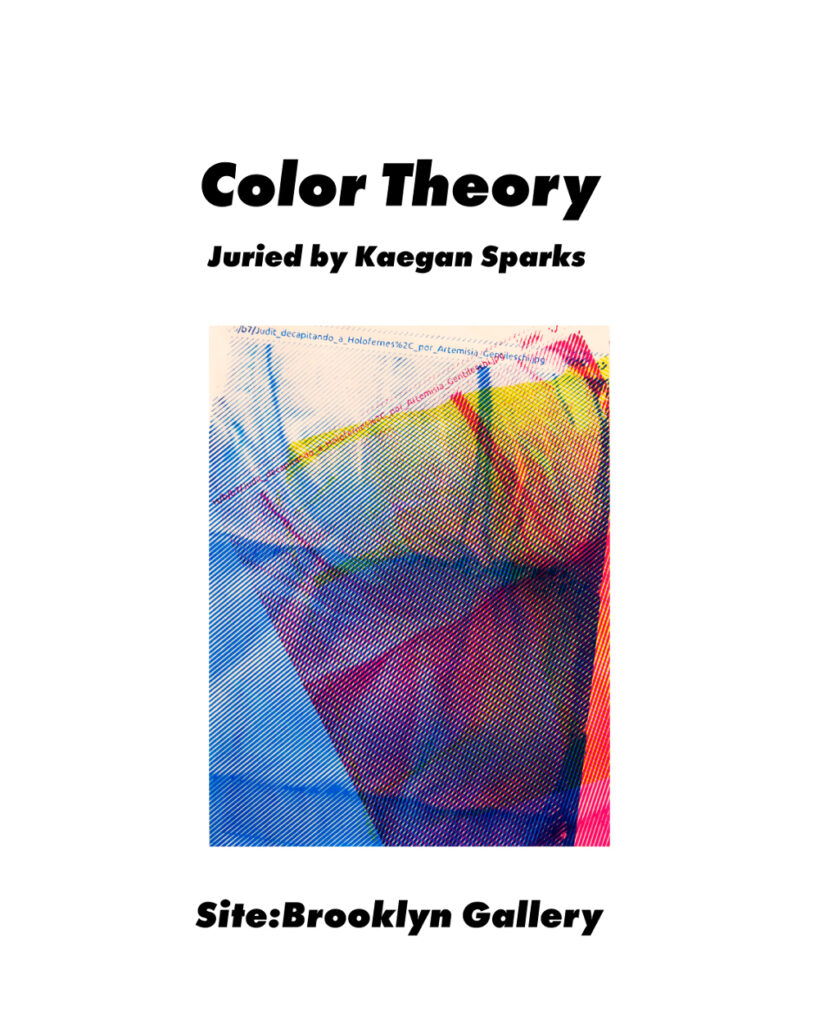
Personalized exhibition card with
Artemisia Gentileschi, Judith Beheading Holofernes_033
Silkscreen print on paper (Lana Colours, 45% cotton rags, 160 g/qm), 65 cm x 50 cm, unique, 2023

Personalized exhibition card with
Artemisia Gentileschi, Judith Beheading Holofernes_033
Silkscreen print on paper (Lana Colours, 45% cotton rags, 160 g/qm), 65 cm x 50 cm, unique, 2023
2023
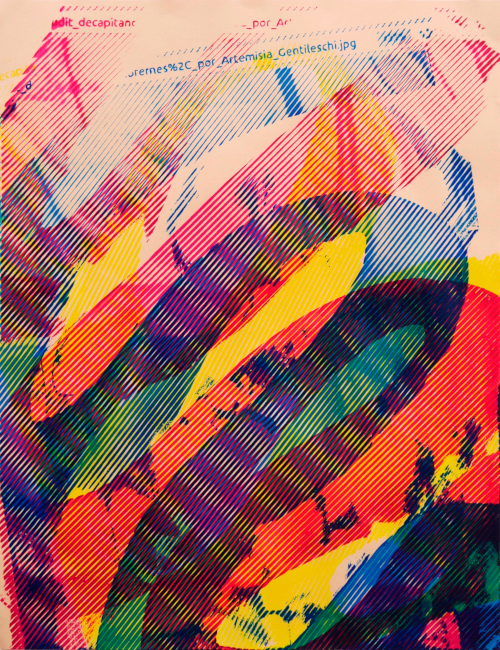
Siebdruck auf Papier (Lana Colours, 45% Baumwollhadern, 160 g/qm)
65 cm x 50 cm, Unikat
Silkscreen print on paper (Lana Colours, 45% cotton rags, 160 g/qm)
65 cm x 50 cm, 25.5″ x 19.75″, unique
Mein Interesse an Siebdruck folgt dem Sachverhalt, dass er die Malerei revolutioniert hat. Meine Arbeiten auf Papier sind immer im Zusammenhang mit dem Performativen zu verstehen: Konzept, Kalkül, “poetry of action” (Henri Focillon).
Das Motiv auf der Siebdruckschablone ist ein Bildschirmfoto – aufgenommen mit Open-Source-Software – mit einem Detail von „Judith Beheading Holofernes“ (ca. 1620) von Artemisia Gentileschi. Die Schablonenkopie wurde mittels UV-Strahlung der Sonne belichtet. Via Hard Fork im Algorithmus meines Druckprozesses schaffe ich eine neue Einheit. Durch Rotation wird jede Farbe (Gelb – Magenta – Cyan) – in einem anderen Winkel gedruckt, wobei der je gleiche Rahmen mit nur einer Schablone verwendet wird. Jede Arbeit ist ein Unikat.
My interest in screen printing follows the fact that it revolutionized painting. My hand-pulled silkscreens are always to be understood in the context of the performative: concept, reflective attitude, “poetry of action” (Henri Focillon).
The motif on the stencil is a screenshot – taken with open source software – with a detail of ‚Judith Beheading Holofernes‘ (c. 1620) by Artemisia Gentileschi. The stencil copy was exposed by means of UV radiation from the sun. Via Hard Fork in the algorithm of my printing process I make a new unit. By rotation, each colour (Yellow – Magenta – Cyan) is printed in a different angle, using the same frame with only one stencil. Each work is unique.
2023
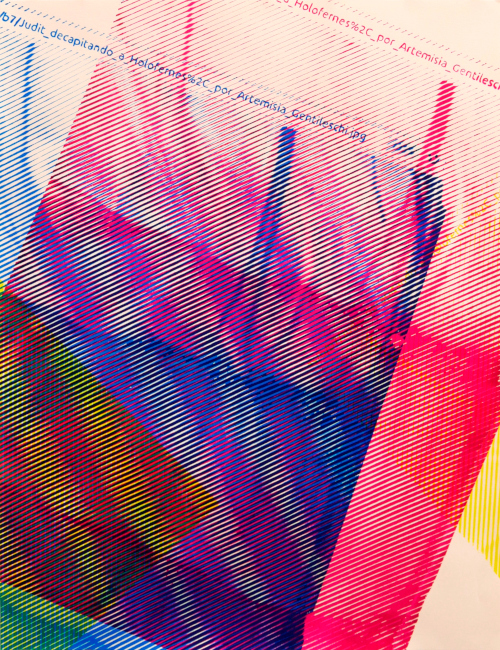
Siebdruck auf Papier (Lana Colours, 45% Baumwollhadern, 160 g/qm)
65 cm x 50 cm, Unikat
Silkscreen print on paper (Lana Colours, 45% cotton rags, 160 g/qm)
65 cm x 50 cm, 25.5″ x 19.75″, unique
2023
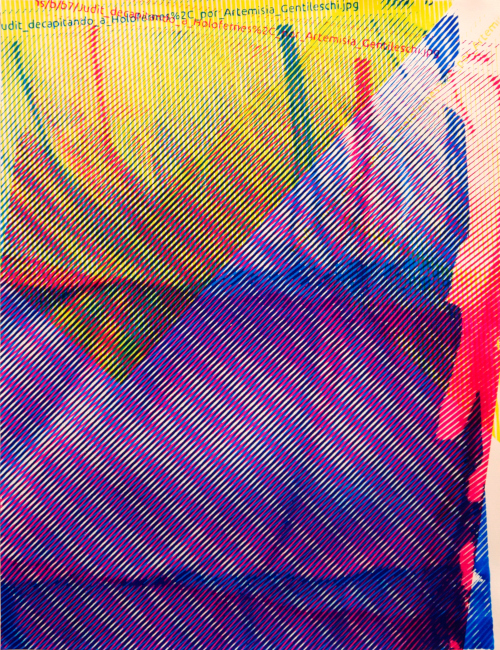
Siebdruck auf Papier (Lana Colours, 45% Baumwollhadern, 160 g/qm)
65 cm x 50 cm, Unikat
Silkscreen print on paper (Lana Colours, 45% cotton rags, 160 g/qm)
65 cm x 50 cm, 25.5″ x 19.75″, unique
2023
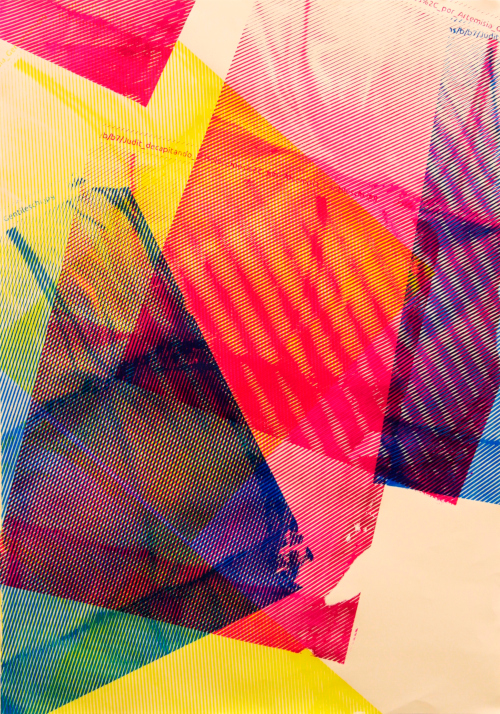
Siebdruck auf Papier (Lana Colours, 45% Baumwollhadern, 160 g/qm)
100 cm x 70 cm, Unikat
Silkscreen print on paper (Lana Colours, 45% cotton rags, 160 g/qm)
100 cm x 70 cm, unique
2023
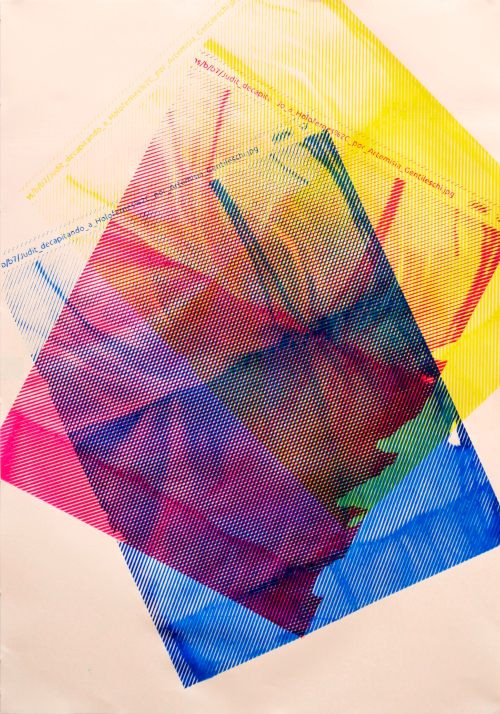
Siebdruck auf Papier (Lana Colours, 45% Baumwollhadern, 160 g/qm)
100 cm x 70 cm, Unikat
Silkscreen print on paper (Lana Colours, 45% cotton rags, 160 g/qm), 100 cm x 70 cm, unique
2023
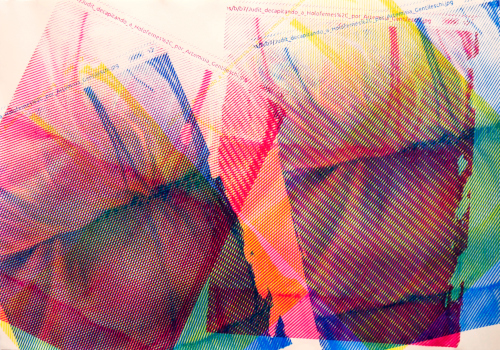
Siebdruck auf Papier (Lana Colours, 45% Baumwollhadern, 160 g/qm)
70 cm x 100 cm, Unikat
Silkscreen print on paper (Lana Colours, 45% cotton rags, 160 g/qm)
70 cm x 100 cm, unique
2023
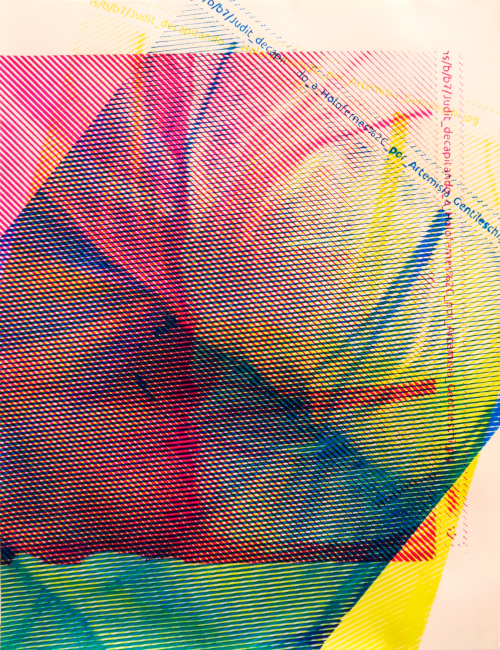
Siebdruck auf Papier (Lana Colours, 45% Baumwollhadern, 160 g/qm)
65 cm x 50 cm, Unikat
Silkscreen print on paper (Lana Colours, 45% cotton rags, 160 g/qm)
65 cm x 50 cm, 25.5″ x 19.75″, unique
2023
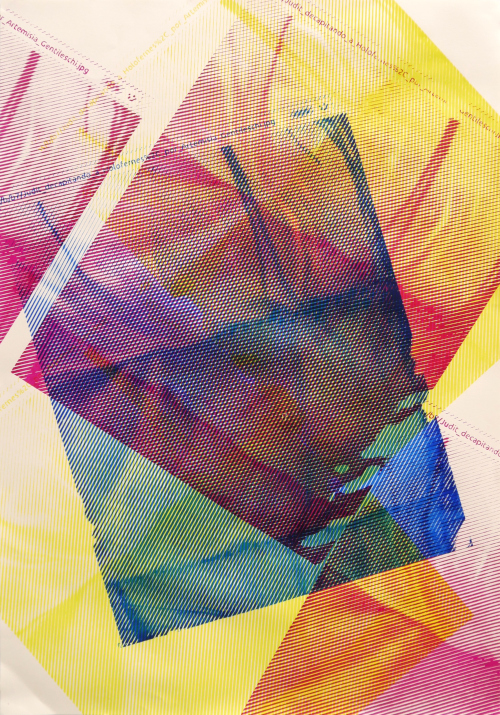
Siebdruck auf Papier (Lana Colours, 45% Baumwollhadern, 160 g/qm)
100 cm x 70 cm, Unikat
Silkscreen print on paper (Lana Colours, 45% cotton rags, 160 g/qm)
100 cm x 70 cm, unique
2023
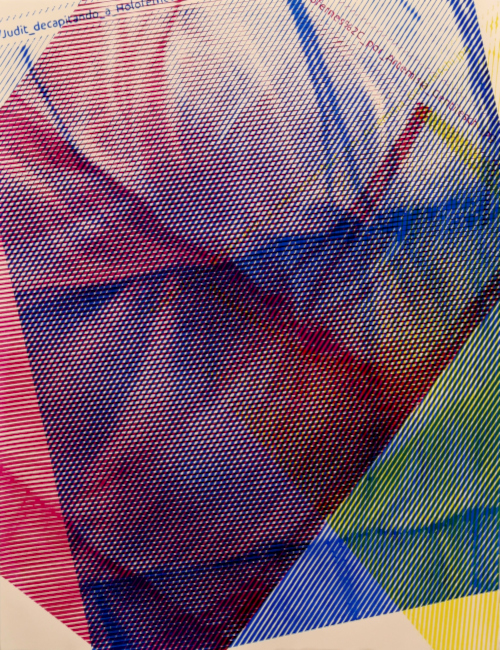
Siebdruck auf Papier (Lana Colours, 45% Baumwollhadern, 160 g/qm)
65 cm x 50 cm, Unikat
Silkscreen print on paper (Lana Colours, 45% cotton rags, 160 g/qm)
65 cm x 50 cm, 25.5″ x 19.75″, unique
2023
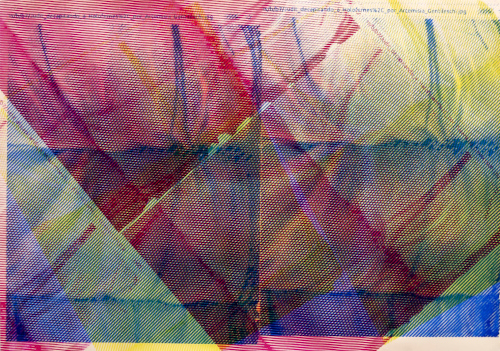
Siebdruck auf Papier (Lana Colours, 45% Baumwollhadern, 160 g/qm)
70 cm x 100 cm, Unikat
Silkscreen print on paper (Lana Colours, 45% cotton rags, 160 g/qm)
70 cm x 100 cm, unique
2022
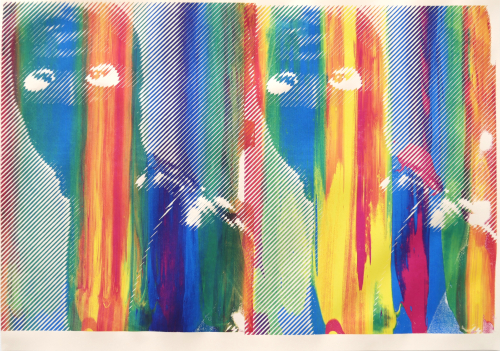
Siebdruck auf Papier, 70 cm x 100 cm, Unikat
Silkscreen print on paper, 70 cm x 100cm, unique
Meine Arbeiten auf Papier sind immer im Zusammenhang mit dem Performativen zu verstehen: Konzept, Kalkül, “poetry of action” (Henri Focillon). Via Hard Fork im Algorithmus meines Druckprozesses schaffe ich eine neue Einheit. Die Druckfarben werden auf dem Siebdrucksieb gemischt; zuvor gewählt aus Cyan, Magenta, Yellow, Key. Alle Drucke sind von mir handgedruckt. Jeder Zug erschafft ein unikales Farbenfeld. Das Motiv auf dem Sieb ist ein Bildschirmfoto von Irma Vep.
„Jamais, entendez-vous, jamais je ne recevrai un ordre de qui que ce soit …“ (Irma Vep).
My works on paper are always to be understood in the context of the performative: concept, reflective attitude, “poetry of action” (Henri Focillon). Via Hard Fork in the algorithm of my printing process I make a new unit. The printing colours are mixed on the silkscreen; respectively chosen from Cyan, Magenta, Yellow, Key. All screen prints are hand-pulled by me. Each pull creates a unique field of colours. The motif on the screen is a screen shot of Irma Vep.
„Jamais, entendez-vous, jamais je ne recevrai un ordre de qui que ce soit …“ (Irma Vep).
2022
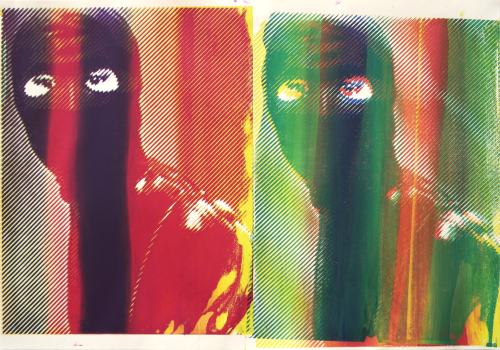
Siebdruck auf Papier (Lana Colours, 45% Baumwollhadern, 160 g/qm)
70 cm x 100 cm
Unikat
Silkscreen print on paper (Lana Colours, 45% cotton rags, 160 g/qm)
70 cm x 100 cm
unique
2022
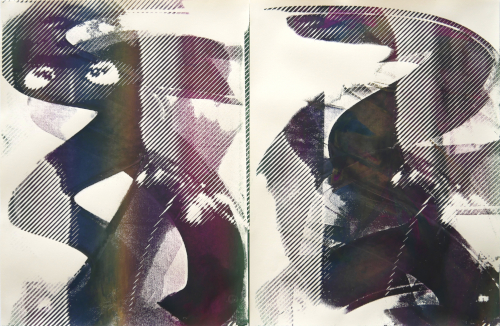
Siebdruck auf Papier (Lana Colours, 45% Baumwollhadern, 160 g/qm)
2-teilige Arbeit, 65 cm x 100 cm
Unikat
Silkscreen print on paper (Lana Colours, 45% cotton rags, 160 g/qm)
2-part work, 65 cm x 100 cm
unique
2021…
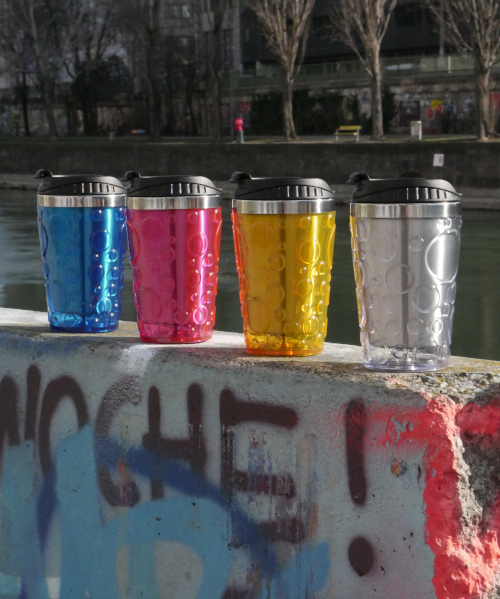
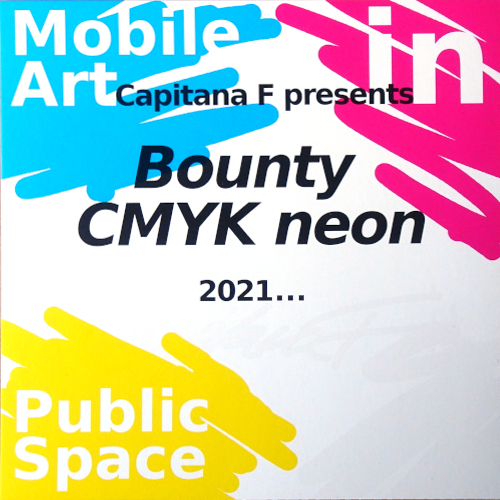
Mobile Art in Public Space
beyond Becher-Schule
multi-part work
– 4 thermo tumbler (Becher): outside cup: SAN, inside cup: stainless steel, lid: PP; each ca. 15 x 8,5 x 8,5 cm, cup height without lid 12,5 cm, fits under common coffee machines, capacity ca. 300ml, leak proof, free from BPA (softener), double-walled, holds drinks up to 1,5 hour hot or cold.
– 1 certificate: offset print, screen print partial UV-varnish, 290 g cardboard, unframed ca. 15 x 15 cm, framed ca. 19 x 19 cm (museum quality, stamped by Capitana F).
Bounty CMYK neon enables the option of action beyond Becher-Schule via Mobile Art in Public Space, to integrate art into life (Situationist International, Beuys etc.), themed “Refill instead of throwing away”. Therefore, Bounty CMYK neon is designed as a so-called “unlimited edition”, only limited by limited resources (Club of Rome etc.).
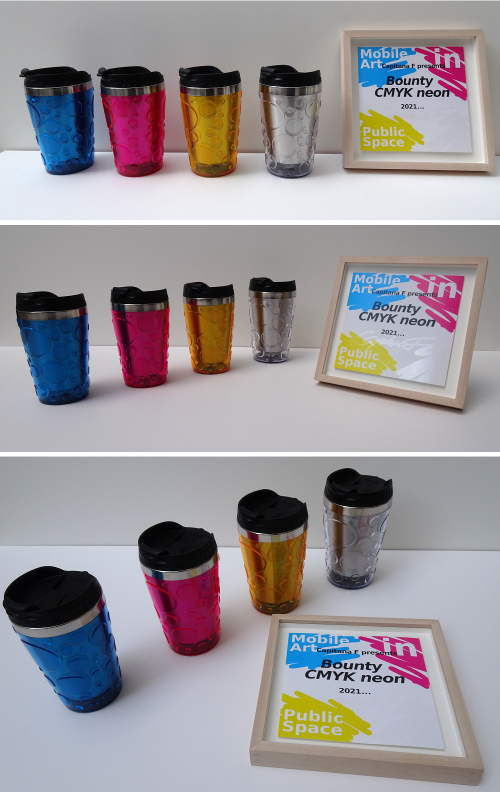
My works on paper are always to be understood in the context of the performative: concept, reflective attitude, “poetry of action” (Henri Focillon). The source material of CMYK masked blue chips-series are screenshots of websites, captured by open-source software, printed on paper which has been painted with one of the four printing colours respectively. All screen prints are hand-pulled by me.
2019
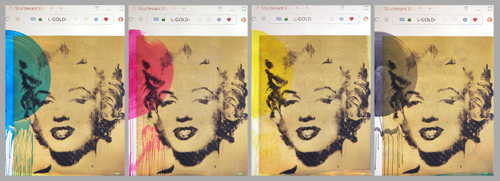
Acrylic and screen print on paper
4-part work; the first of five series each consisting of 4 unique pieces, each 100 cm x 70 cm
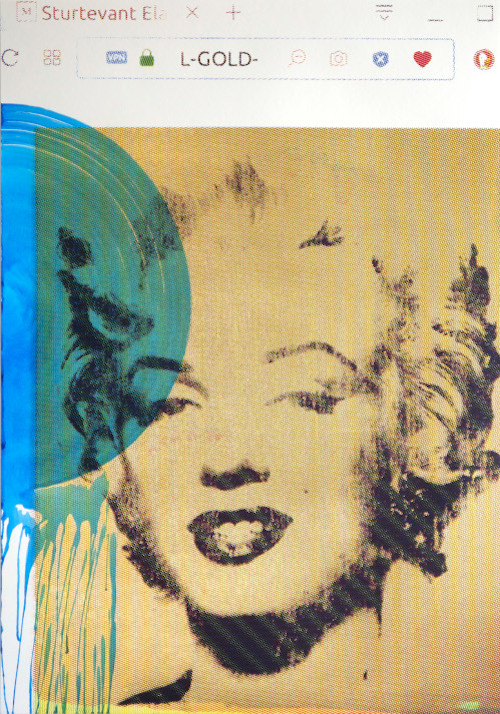
The first picture of 4-part work, 100 cm x 70 cm
Invisible Sculpture is based on a reversal of the sculptural working technique of the lost mould. Understood as a process result, each Invisible Sculpture comprises various types of materiality or medium/form variations. In order to secure the trace evidence, something totally arbitrary is placed on a working underlay and treated with colour. This initial manoeuvre is followed by the partial marking of the arbitrary item via moulding. The result from the separation of the two, i.e. the physical marking on the one hand and the subtraction of the arbitrary item on the other, is sensual data which activates the reversal. The “temporary markings” (Rosalind E. Krauss) are captured via long-exposure photographs or video.
2015-2019
– acrylic, plaster, ‘Rasen Green’ colour 07 grey with drainage naps, antistatic, luxury class 2, framed ca. 139 cm x 242 cm x 4 cm
– video, projection in upright format, 4:3, PAL, colour, original sound, loop
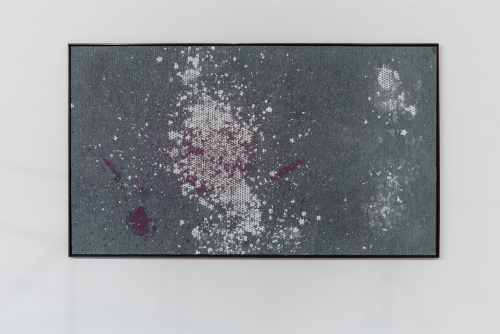
working underlay, photo: Dirk Uebele
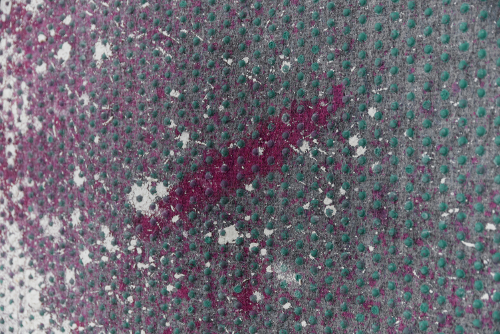
detail working underlay, photo: Dirk Uebele
2019
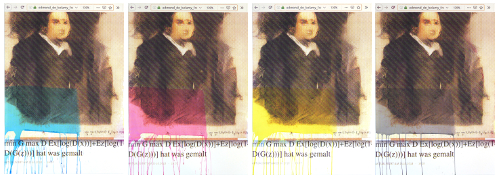
Acrylic and screen print on paper
4-part work; the first of five series each consisting of 4 unique pieces, each 100 cm x 70 cm
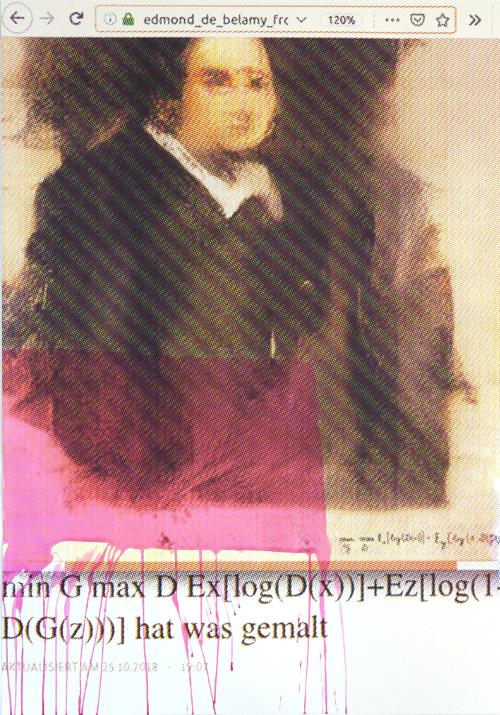
The second picture of 4-part work, 100 cm x 70 cm
https://www.nytimes.com/2018/10/25/arts/design/ai-art-sold-christies.html
https://en.wikipedia.org/wiki/Edmond_de_Belamy
2018
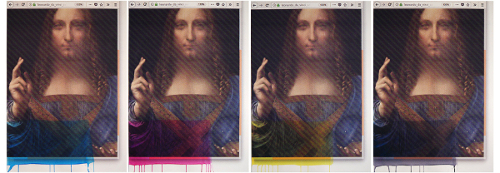
Acrylic and screen print on paper
4-part work; the first of five series each consisting of 4 unique pieces, each 100 cm x 70 cm
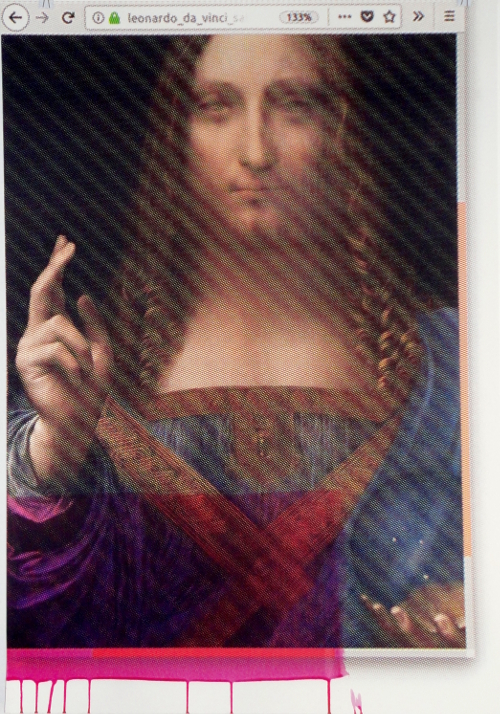
The second picture of 4-part work, 100 cm x 70 cm
https://en.wikipedia.org/wiki/Salvator_Mundi_(Leonardo)
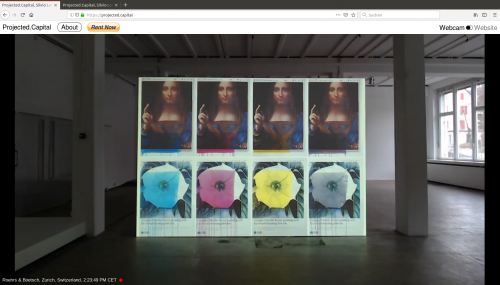
Screenshot live-stream/ Exhibition view
Projected.Capital, Roehrs & Boetsch, Zurich, Switzerland, 2018
2018
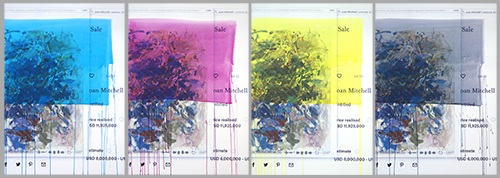
Acrylic and screen print on paper
4-part work; the first of five series each consisting of 4 unique pieces, each 100 cm x 70 cm
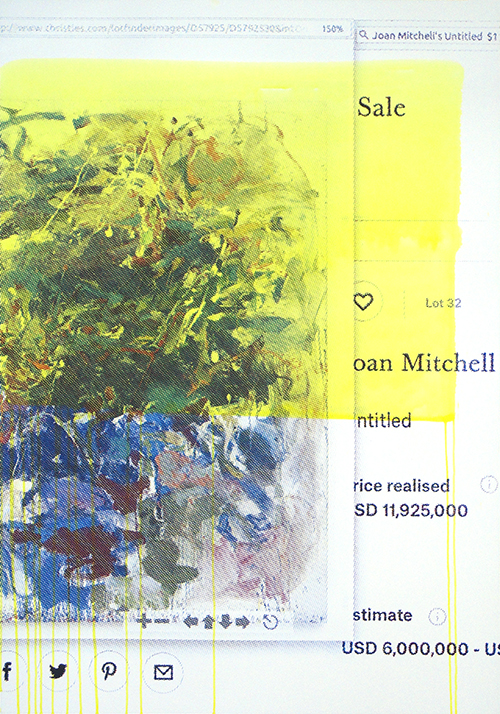
The third picture of 4-part work, 100 cm x 70 cm
“A Klee painting named Angelus Novus shows an angel looking as though he is about to move away from something he is fixedly contemplating. His eyes are staring, his mouth is open, his wings are spread. This is how one pictures the angel of history. His face is turned toward the past. Where we perceive a chain of events, he sees one single catastrophe which keeps piling wreckage upon wreckage and hurls it in front of his feet.”
Walter Benjamin
2017
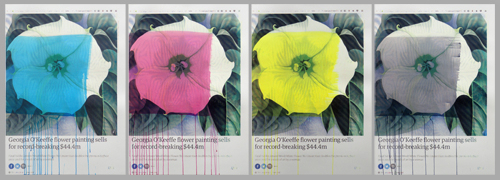
Acrylic and screen print on paper
4-part work; the first of five series each consisting of 4 unique pieces, each 100 cm x 70 cm
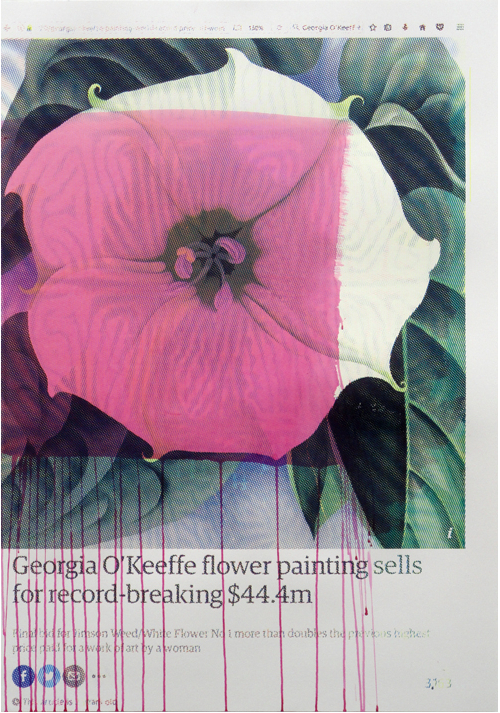
The second picture of 4-part work, 100 cm x 70 cm
2014
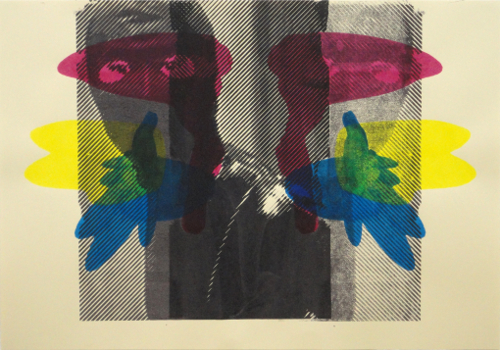
acryl, silkscreen print on paper, 70 cm x 100 cm
2014
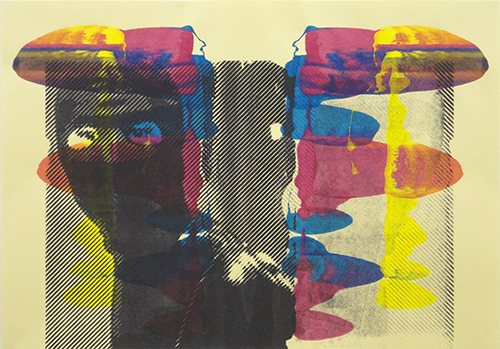
acryl, silkscreen print on paper, 70 cm x 100 cm
2014
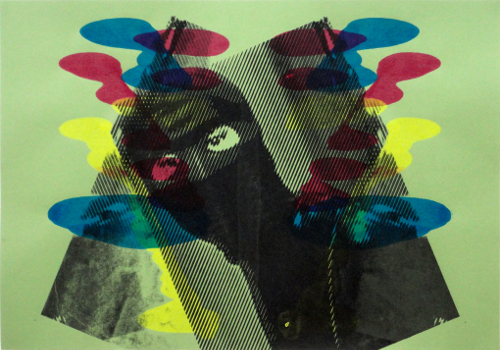
acryl, silkscreen print on paper, 70 cm x 100 cm
2017
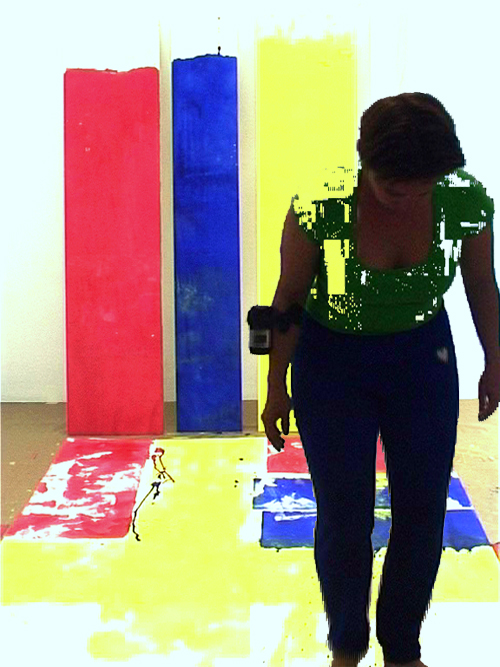
video, colour, original sound, 4:3 upright format, 6 min 38 sec, presentation as loop
PRESSURE is not just the making-of a length of paper, 150 centimetres wide and 1000 centimetres long (59.06 x 393.7 inches), which is printed with primary colours exclusively through the artist’s own body.
In fact the art video clip, with reference to Piet Mondrian – in respect and as well critical distance to his reductionism or rather essentialism – is a reflection about the current question: How to merge analogue life with the rapid digital progress?
2011-2016
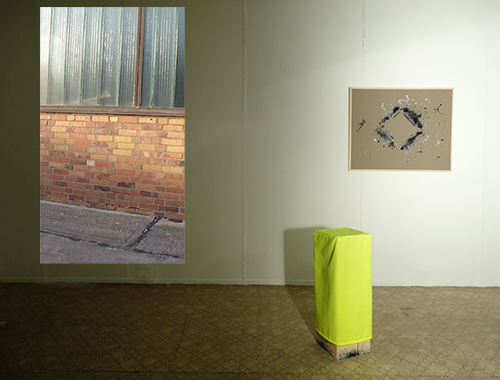
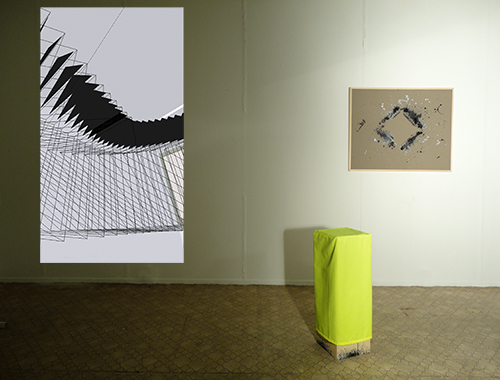
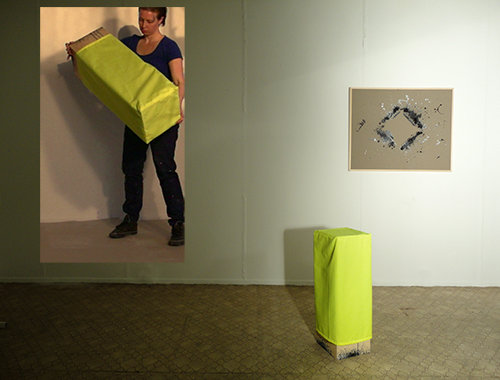
studio view, Berlin
video, colour, original sound, 16:9 upright format, 12 min 21 sec, loop, presentation as projection (variable)
age-resistant museum board made from 100% cotton fibre, museum quality, ink, framed ca. 104 x 84 cm
pedestal: ply wood, ink, with mask made from Foreman, neon yellow, 79 x 27 x 27 cm
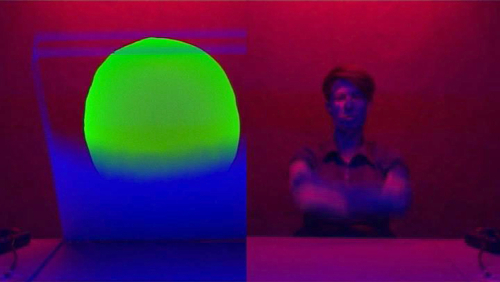
Video still image from: Person #24, video performance. 2012
“(…) the philosopher Judith Butler asks how does power, upon which the subject’s existence depends and which it is compelled to repeat, turn against itself during the process of repetition? How is resistance conceived in concepts of repetition? (Judith Butler, 2002: 27) In Butler’s opinion divergence and difference are immanent to the unavoidable repetition of gender stereotypes, since it is impossible to create identical copies of an original. From this she concludes that there is an inherent deviancy within the prevailing heteronomous gender images.
In the context of modern and contemporary art it would be possible to accompany this type of gender theory, based on so-called gender studies, with reflections on the constitution of the subject, as found for instance in serial art in the early 1960s and the (feminist) performance, body art and video works since the 1970s. (…)”
Sabeth Buchmann, excerpt from: Woman without Qualities | Art with Qualities. In: Karin Felbermayr, Performative Elements. Verbrecher Verlag, Berlin 2007. translation: Ann Robertson
2016
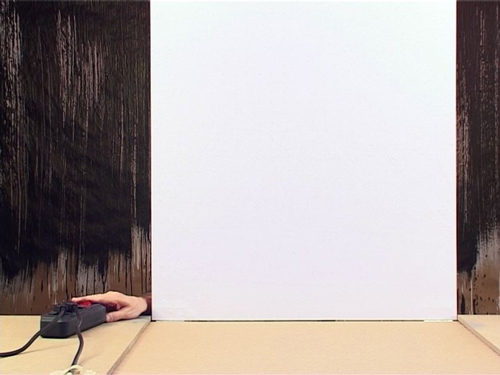
Video performance, colour, original sound, 1 min 57 sec, loop, presentation as projection
Person #25 combines conceptually video and performance to video performance. In this work I repeatedly perform a choreography of different gestures and poses, which I took from perfume advertisements. The editing follows the animation concept of thaumatrope. It includes the use of several masking techniques: black and white stage make-up, black and white ink, rectangle, technical mask (keying), coloured light etc.
http://archive.j-mediaarts.jp/en/festival/2017/art/works/20aj_person_25/
My works on paper are always to be understood in the context of the performative: concept, reflective attitude, “poetry of action” (Henri Focillon). The mirrored-series is based on the Rorschach method. The series 3 Stoppages étalon is a reference to Marcel Duchamps 3 Stoppages étalon.
„Jamais, entendez-vous, jamais je ne recevrai un ordre de qui que ce soit …“ (Irma Vep)
2016
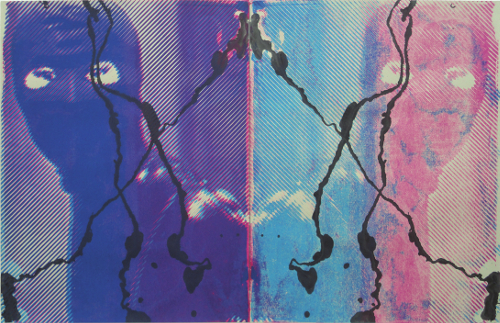
ink, silkscreen print on paper, 2-part work, 65 cm x 100 cm
2016
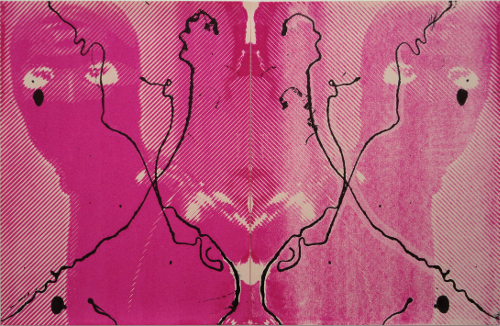
ink, silkscreen print on paper, 2-part work, 65 cm x 100 cm
Sabeth Buchmann: Woman without Qualities / Art with Qualities. In: Karin Felbermayr, Performative Elements, Verbrecher Verlag, Berlin 2007. Translation: Ann Robertson.
Post avant-garde and neo-avant-garde artists and art theorists of both genders have endeavoured to “re-gender” modern art and art history through analysis and confrontations with anti-binary counter images parallel to the development of prescribed societal and medial perceptions of a woman/man, female/male gender difference. Insights into the socially produced nature of subjects succeeded in sensitizing people towards the performative, i.e. speech and action, character of gender and gender identity, and broadened the scope of current feminist representation critique: according to this view, gender-specific power relationships based on male and female qualities are the result of repetitive subjectivization and identification processes which take place in and through language. In this context the philosopher Judith Butler asks how does power, upon which the subject’s existence depends and which it is compelled to repeat, turn against itself during the process of repetition? How is resistance conceived in concepts of repetition?[1] In Butler’s opinion divergence and difference are immanent to the unavoidable repetition of gender stereotypes, since it is impossible to create identical copies of an original. From this she concludes that there is an inherent deviancy within the prevailing heteronomous gender images.
In the context of modern and contemporary art it would be possible to accompany this type of gender theory, based on so-called gender studies, with reflections on the constitution of the subject, as found for instance in serial art of the early 1960s and the (feminist) performance, body art and video works since the 1970s.
Minimalist artists of both genders, influenced by Maurice Merleau-Ponty’s “Phenomenology of Perception”, asked how a subject experiences the objects of its observation; the recipient supposedly experiences his or her subject status in keeping with the ideal-typical image through the bodily relation to the serial object, thus constituting himself/herself as body and consequently, as the art historian Rosalind Krauss formulated, banishing what was felt to be the disembodied and bloodless, algebraicized condition of abstract art (which prevailed at that time SB)[2] – a direction in art which, according to Krauss, drew on the concept of a transcendental entity based on rationality and called “subject”.[3]
In contrast to this, the reception-oriented work concept of minimal art propagated a consciousness of spatial coordinates and primary forms precursory to vision and recognition: thus the phenomenologically conceived subject distinguishes itself through the assumed ability to discern shape and form in an act of bodily intuition – a notion that fundamentally contradicted the primacy of visual perception within the modernistic concept of the observer’s perceptual resources. This was countered with the assertion of a pure presence of the “object” in time and space (“presence” and “place”), which ricocheted onto the conception of the observing subject: this subject supposedly only discerned itself as a radically contingent position in the here and now. Here Krauss sees an attempt to compensate a subject, whose everyday experience has become increasingly isolated, reified and specialized, a subject who leads an increasingly instrumentalized existence under the conditions of an advanced industrial culture.[4] In her opinion the draft of a “radically contingent subject” contains the potential of resistance against stereotyping, goods production, the promise of a moment of bodily fulfilment. Krauss describes this as a “compensatory gesture” which we discern as deeply aesthetic.[5]
I refer to Krauss in such detail because, among other things, she argues with a constitutive figure in aesthetic modernism which sees art in a position of contradiction to the industrialization and rationalization of daily life. However, in Krauss’ interpretation of phenomenology, as developed by minimalism, this figure is conceived not as an entity inherent in the work, but as a quality in the recipient. In her revision of minimalism Krauss admits that in the model of the “radically contingent subject” the logic of capitalist goods production is structured in such a way that it could disintegrate into the utterly fragmented postmodern (i.e. without resistance SB) subject of contemporary mass culture.[6]
Such rather pessimistic revisions of pre-feminist conceptions of the subject can now be combined with the feminist discourses which, drawing on postmodern cinema theories, expand the minimalist reflections of the relationship between subject/object/space/body using the figure of the screen, thus leading to a discourse on perception and images, such as that formulated by cultural theoretician Kaja Silverman with a psychoanalytical focus: she argues that the conditions surrounding subjectivization and (self-)identification are fundamentally enmeshed in the visual patterns and structures of modern media and consumer culture. In this context the metaphor of the “screen” describes the way in which subjects draft themselves and their gender identity through viewing the object/image: the confirmation of an identitical and/or gender-specific self can thus only take place through the imagined gaze of an authority that has been internalized by the subject and is, however, projected to an outside. Just as minimalism endeavoured through the reception of phenomenology to overcome the dualistic subject-object division, the figure of the screen implies an intertwined gaze relationship between subject and object which at the same time reveals the relationship between body and space as something fragmentary and contingent, i.e. as something materializing in the momentary here and now: in this way three-dimensional, physical phenomena present themselves to us as surfaces, as unstable projections, which we think to be the truth (about the body and the space). In other words it is impossible to conceive the perception relationship of subject/object/body/space independent of mutually constitutive subjectivizing and visualizing mechanisms, in which – depending on the constitution of the predominant culture – specific “visual regimes” (Silverman) manifest themselves. In the same way as Butler tries to break up heteronormative gender images and, like Krauss, reflects on the resistance of the subject to the advanced circulation of goods, Silverman asks how the dominant visual regime can be counteracted.[7] In so far as she too thinks of the subject’s position as contingent, because it only sees from its respective position of view and is thus limited to its range of vision, Silverman links up with Jacques Lacan and determines the relationship between the subject and the world as both fragmentary and imaginary. After all, the subject’s inherent “screen” consists of imaginary pictures which structure the subject’s relationship to the world. In analogy to the “screen” Silverman thus refers to a photographic gaze which the subject directs towards itself. It always anticipates the poses which match its self-image (as woman, as man etc.): the pose localizes the subject as a mask which, desiring to be seen in a specific form, speaks. On the one hand the pose produces a space via gaze relationships, a kind of imaginary stage background. “The pose always involves both the positioning of a representationally inflected body in space, and the consequent conversion of that space into a place.”[8]
For this particular contribution this means that the radically contingent subject of minimal art can be placed in a relationship to the activated individual production of the gaze within the circulation of goods of the modern media and consumer culture. To argue with Butler, this does not necessarily lead – as Krauss maintains – to the loss of resistance: in the context of gender formation this would in fact depend on the degree to which the form of repetition can be directed against itself. But it is at this point, at the latest, that we come across an aporia, which Butler herself points out: how can thought begin about a subject which influences the form of repetition, when this subject itself is nothing other than the (imaginary) product of subject constituting repetition?[9]
Finally, the concept of performance further intensifies these briefly sketched connecting lines between the phenomenology of minimalism, recent gender discourses and cinema or image theory.
In the context of currently common formats, which include media such as photography, television, video and digital technologies, the art historian and curator Silvia Eiblmayr defines the “performative” as the “pivotal point in that dialectic (…), how the artistic conception of works and the mode of their perception intertwine with each other (…): in the performative, the moment of the “theatrical”, which characterizes all these expanded forms of fine art, combines with the verbal.”[10] And this also means that the “space itself, or the place, in which the work of art happens, is exhibited or performed, is reflexively integrated into its conception.”[11]
Although at this point I would like to avoid the misleading equation of theatrical performance and linguistic performance, which is so important in gender studies, the two categories can in fact be used in reference to Karin Felbermayr’s works: particularly with reference to the form in which the object, body and space are never solely represented as “real”, but as imaginary and literally projected topoi, an aspect which – similar to minimalism – integrates the observer’s range of vision in the spatial production of the objects.[12] Meanwhile, the basic geometrical forms of serial art have evolved into projection surfaces (screens) which are literally overwritten by medialized genders: we see this in the series of works with ink on paper entitled “Mask”, grotesquely enlarged hand and foot motifs reminiscent of comic drawings, which dominate the image area in such a way that the body is reduced to elliptical shadows, consequently providing a clue which negatively cites and repeats what it leaves out.
In my opinion this “repetitive negative process” seems significant, as in the case of “Gender Gamble”, to the extent that this video performance not only plays with prevailing gender images but also focuses on, and reveals, gender in the context of a latently invisible institutional reproduction of genderized relationship networks: a meshwork consisting of the apparatus of media images, conventions of their (re)presentation in the exhibition space and the stances of their “consumers” (including the artist and her exhibition visitors), positions split between fashion, art and the body’s theatrical productions of everyday life. In “Gender Gamble” this meshwork culminates in the metaphor of the screen in the shape of an integrated system consisting of camera lens, stage and viewing space: it is a combination of the repetitive procedure executed by the artist in her function as performer of her staged model poses oscillating between images of masculinity and femininity, and the fictitious velocity, which captures the codified acts of gender production with medialization processes as a relationship between subject(s) and object(s) of observation in time and space.
In this sense, and independent of their medial status, Felbermayr’s works in ink, objects and performances run counter to both an ostensible essence of the portrayed and the essence of the portrayal: it is only during the growing awareness of the functional-metaphorical linking of exhibition space and stage, of body presentation and technical apparatus, that the presented images and objects reveal themselves as elements of a significative revision of those relationships, which we observers create between them. The network of relationships between subject/object/body/space can be interpreted as an indexial reference system implying alternative possible forms of combination.
If we pursue Felbermayr’s motto “Stereotype as a Masquerade”, then “Mask” stands for that which determines the production conditions of identity (as men and/or women). Just as Butler maintains that deviation from the norm is constitutive of the norm itself, it is the distorting and fictionalizing appearance of gender characters which suggests the existence of a supposedly “submerged” hidden truth, but this in turn is only an imagined image, one we cannot actually see, but are only able to project. Consequently, rather than implying any certainties about the empirical reality of gender identities, “Mask”, “Gender Gamble” and “Stereotype as a Masquerade” demonstrate to us that these are unstable “repetitions” of image citations: ranging from Spiderman through cyborgs to masked demonstrators or Frantz Fanon’s “Black Skin White Masks”, such images turn out to have superimposed, multi-layered, sometimes contradictory levels of meaning with countless breaks. Nevertheless, this does not inevitably restrict the ideological effect of media cultural, political and theoretical narrations which are evoked by the mask topos.
As is well-known, Judith Butler’s classic “Gender Trouble” (1990) was criticised to the effect that her deconstruction of gender could be transferred to parodistic practices within specific subculture milieus, but her sex-gender system – according to which not only the social but also the biologically accentuated gender is an effect of previous discourses – was unable to encompass social conditions of power or the power over reality of prevailing gender ideologies. For this reason her sex-gender system was not suitable for a further development of thought in the feminist emancipation project, because she robbed lesbian, queer and heterosexual women of the necessary identity-political foundation that is needed to gain the ability to take action.
Some artists argue in a similar direction, for instance Andrea Fraser, who declared in an interview that deconstructive feminism of the eighties and nineties bypassed the dimension of the collective struggle.[13] According to a frequent criticism, by linking the gender discourse with the performativity theorem, feminism adapted to that multi-identity flexibility required by the post-Fordist production system. Finally, such arguments can also offer explanations as to why art institutions found it easier to deal with gender studies of the nineties than the militant feminism of the seventies. Thus slogans such as “flexibilization”, “deregulation”, or “mobilization” advanced to become key concepts within those artistic movements which refer to identity-critical and institution-critical approaches of art in the seventies, and which could – and still can – take up positions against the continuing validity of the art market’s demand for saleable goods. This means that the talk about “fictitious” and “performative” identities and genders rapidly evaporates as soon as artists, in a mixture of freely chosen and compelled self-determination, find themselves confronted with the need to organize their means of production, working spaces, exhibition venues, contacts, distribution channels and audiences by themselves: a process which has become a central issue for artists who integrate the changed conditions of artistic work and the simultaneously conveyed discourses on gender in their interpretations of the relationship between private and public or institutional spaces.[14]
In the face of such objections, and considering the play with gender masks as pursued by Karin Felbermayr in her works, is it possible to make a fresh departure towards a new aesthetic draft of identity politics which is capable of addressing institutionalized politics?
No matter how paradoxical it might sound, in the case of “Gender Gamble” it seems possible to simultaneously take sides for and against a politics of gender which, in the enmeshed mechanisms of identification and disidentification, is necessarily entangled with the prevailing economies. As far as this is concerned, aesthetic deconstructions of gender also have to be viewed in the light of the moderately conservative liberalism of the art business which – no new revelation – is bound up in a mercantile association with the fashion, pop, porno and fitness industries. But if we look at their products (keyword Madonna), then the thesis, that masculinity and femininity are especially fictions and discourse effects, because they are theatrically produced as such, can no longer be simply swept aside as lofty, theoretistic platitudes. This does not mean that the empirical subject is no longer relevant. On the contrary: “Gender Gamble” sensitizes observers to the fact that they always, though not necessarily primarily, become aware of their bodies through fictions and discourses. For this reason, and this is the hope of whole generations of artists championing feminist arguments, precisely these could represent the field of a collectively inspiring revision of the prevailing rules of the game. From this point of view, the performative topos of the screen and the mask already almost represents a kind of ready-made quote, to the extent that it smuggles both the lessons of historical minimalism and feminist-psychoanalytical cinema, image and performance theory into the old difference between the autobiographical-empirical and the narrative-fictional concepts of subject: consequently, gender is not a form of visible information that can be abstracted from the aesthetic manifestation of the body and the space, because we perceive these as images, and thus as undeceiveable masked truths.
[1] Judith Butler: Psyche der Macht. Das Subjekt der Unterwerfung | The Psychic Life of Power: Theories in Subjection. Frankfurt/ Main, 2002, p.27.
[2] Rosalind Krauss: Die kulturelle Logik des spätkapitalistischen Museums | The Cultural Logic of the Late Capitalist Museum. 1990, in German translation in: Texte zur Kunst, Vol. 2, No. 6, June 1992, p. 131-145, here p. 136.
[3] See my remarks in: Sabeth Buchmann: Denken gegen das Denken. Produktion – Technologie – Subjektivität bei Sol LeWitt, Yvonne Rainer und Hélio Oiticica. Berlin 2007, p. 157.
[4] cf. Krauss, loc.cit.
[5] ibid.
[6] ibid., p.140.
[7] Kaja Silverman: Dem Blickregime begegnen. In: Christian Kravagna (ed.): Privileg Blick. Kritik der visuellen Kultur. Berlin 1997, p. 41-64.
[8] Kaja Silverman: The Threshold of the Visible World. New York 1995, here p. 203. I would like to thank the architect and cultural theoretician Christian Teckert for his useful reading suggestions.
[9] See Butler loc.cit.
[10] Silvia Eibelmayr: Schauplatz Skulptur: Zum Wandel des Skulpturenbegriffs unter dem Aspekt des Performativen. In: Sabine Breitwieser/ Generali Foundation (ed.): White Cube/ Black Box. Vienna 1996, p. 75-96, here p.77.
[11] ibid., p.75.
[12] See my considerations in: Sabeth Buchmann: Im Zeichen der Arbeit. In: Alexander Alberro u. Sabeth Buchmann (ed.): Art After Conceptual Art. (Series Sammlung Generali Foundation), Cologne 2006, p. 205-222, here p. 217.
[13] “Feminism & Art: Nine Views”, Artforum International, October 2003, Andrea Fraser: Feminism not only provides institutional critique with a criticial object; it provided a practical methodology. In: Artforum. October 2003, S. 142.
[14] See my considerations in: Im Zeichen der Arbeit. loc.cit., p. 208.
2015
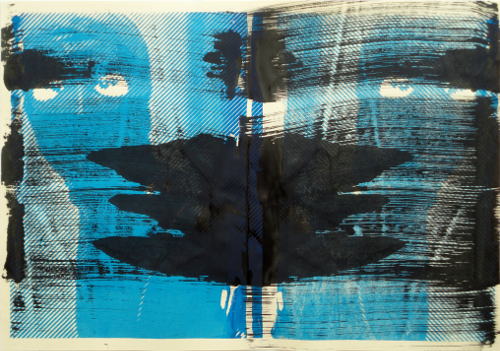
ink, silkscreen print on paper, 70 cm x 100 cm
Catalogue p. 25, Inkmasters 2016 Print Exhibition, Tanks Arts Centre, Cairns, AU
2015
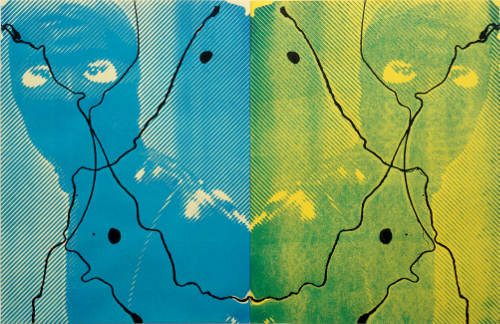
ink, silkscreen print on paper, 2-part work, 65 cm x 100 cm
2015
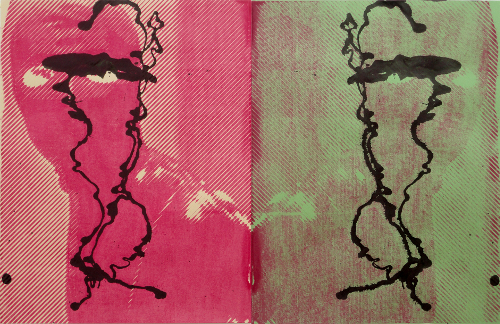
ink, silkscreen print on paper, 2-part work, 65 cm x 100 cm
2015
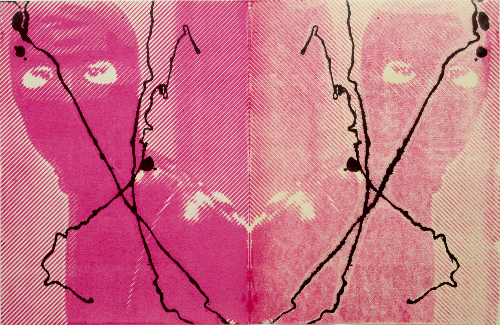
ink, silkscreen print on paper, 2-part work, 65 cm x 100 cm
Catalogue p. 26, Inkmasters 2016 Print Exhibition, Tanks Arts Centre, Cairns, AU
2015
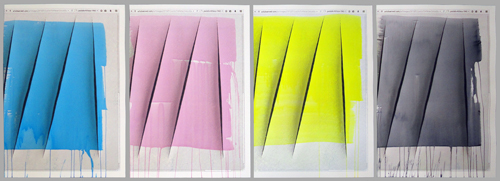
Acrylic and screen print on paper
4-part work; the first of five series each consisting of 4 unique pieces, each 100 cm x 70 cm
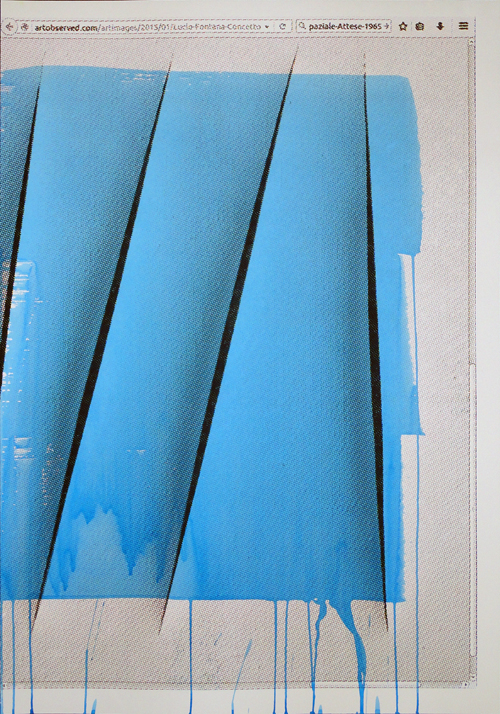
The first picture of 4-part work, 100 cm x 70 cm
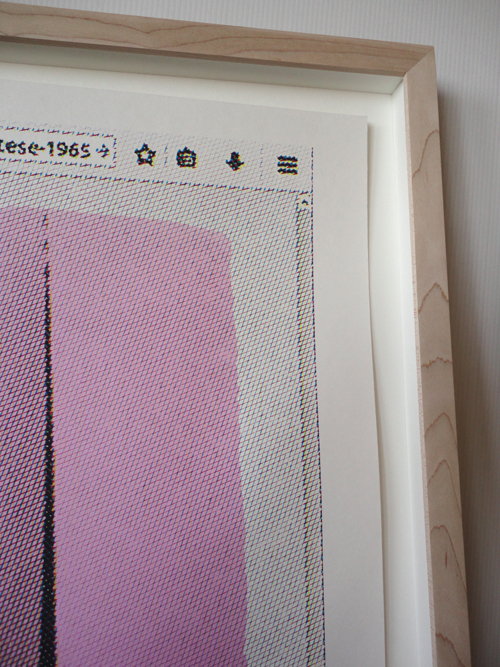
detail
2014
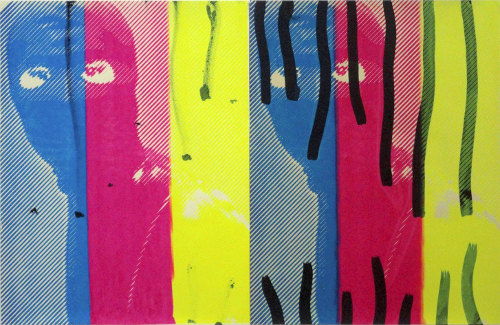
ink, silkscreen print on paper, 2-part work, 65 cm x 100 cm
2015
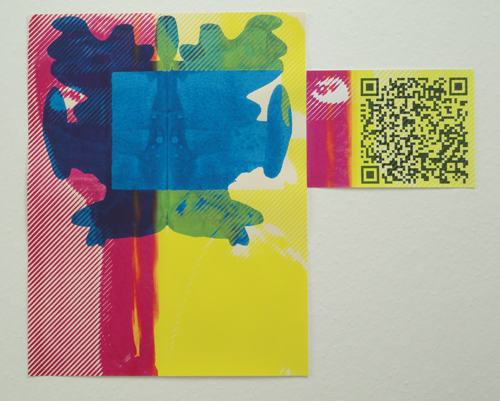
acrylic, xerography, silkscreen print on paper, 2-part work, 65 cm x 50 cm und 21 cm x 29,7 cm
My works on paper are always to be understood in the context of the performative: concept, reflective attitude, “poetry of action” (Henri Focillon). The mirrored-series is based on the Rorschach method.
„Jamais, entendez-vous, jamais je ne recevrai un ordre de qui que ce soit …“ (Irma Vep)
2015
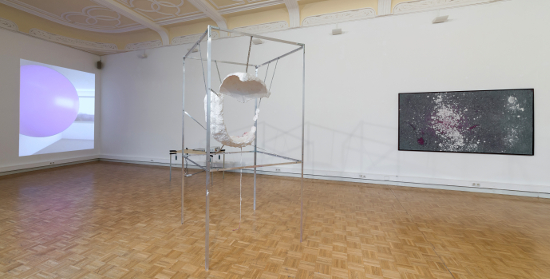
multi-part work:
– Aluminium profiles, plaster, jute, perforated tape, ca. 250 cm x 126 cm x 126 cm
– acrylic, plaster, ‘Rasen Green’ colour 07 grey with drainage naps, antistatic, luxury class 2, framed ca. 139 cm x 242 cm x 4 cm
– video, projection in upright format, 4:3, PAL, colour, original sound, loop
– light
Installation view, photo: Dirk Uebele (detail)
In case of Invisible Sculpture_019 (AXOPn) the arbitrary item is a big balloon, which is filled with helium gas. The „temporary markings“ are provided by a video. The images of the video, in which 3D-generated animation sequences are integrated, have been taken with different cameras (a camera which was positioned on a tripod, action cam). With the pretension to reflect artistically about the peculiarity of 3D-generated space, I made a copy of my Berlin studio for the animations. In the exhibition the working underlay is transcoded to a panel painting.
All installation views and details: Kunstverein Bellevue-Saal, Wiesbaden (DE), two-person exhibition AXOPn with Levent Kunt, 8 October to 1 November 2015
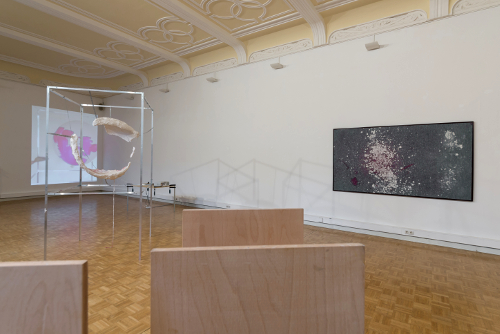
Installation view, photo: Dirk Uebele
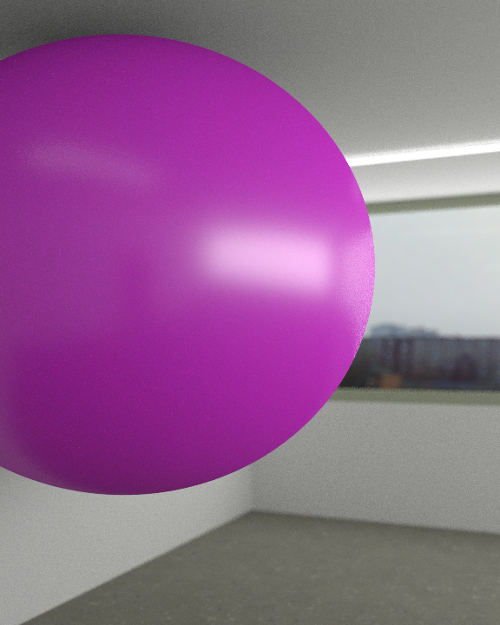
video still
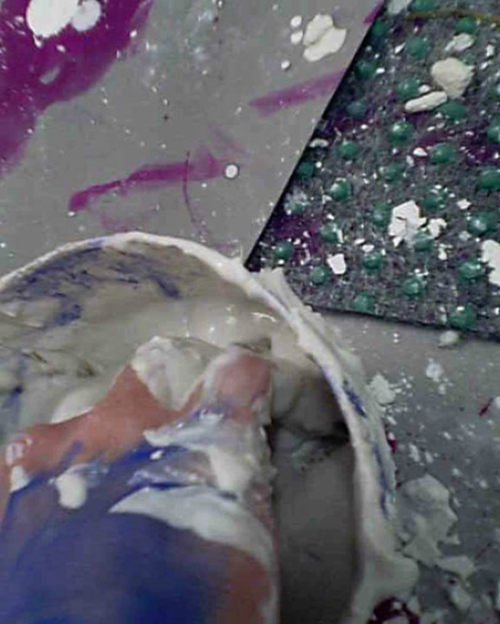
video still
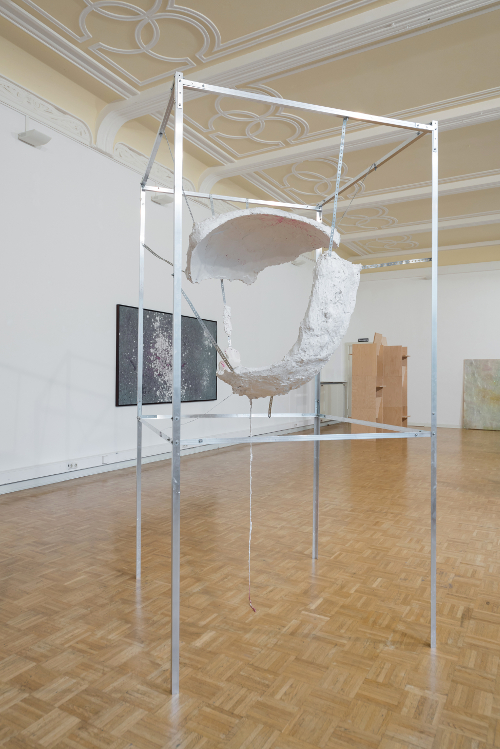
Installation view, photo: Dirk Uebele
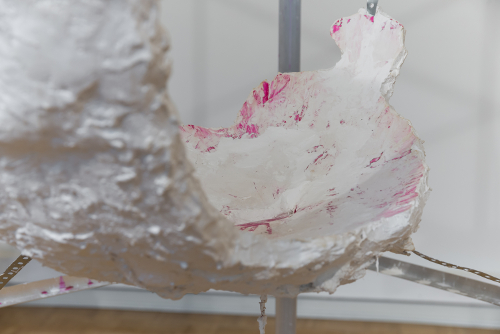
Detail, photo: Dirk Uebele

Detail, photo: Dirk Uebele

Detail, photo: Dirk Uebele
2015-2019
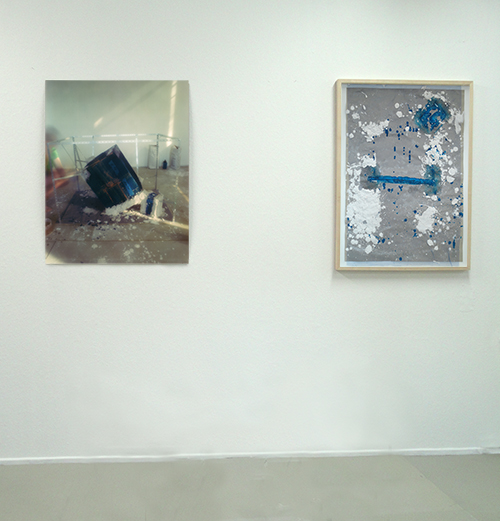
Studio view, Berlin; two-part work:
– Photograph: C-print/ acrylic/ aluminium, 100 x 82 cm
– Plaster, Vaseline, acrylic, textile on paper, framed 109 x 79 cm
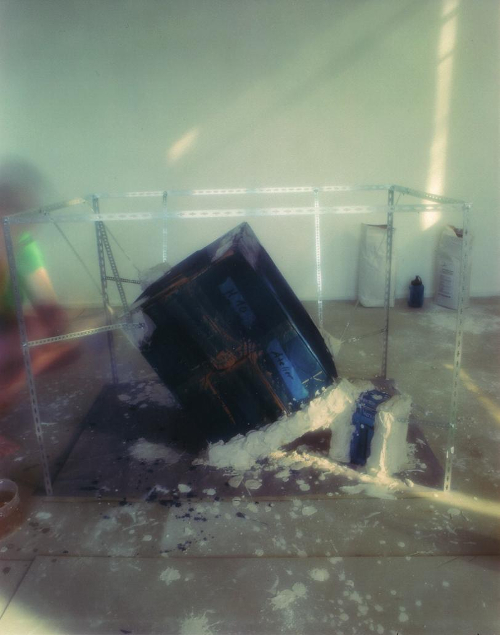
Installation detail: photo, camera: Mamiya RB 67 Pro-S
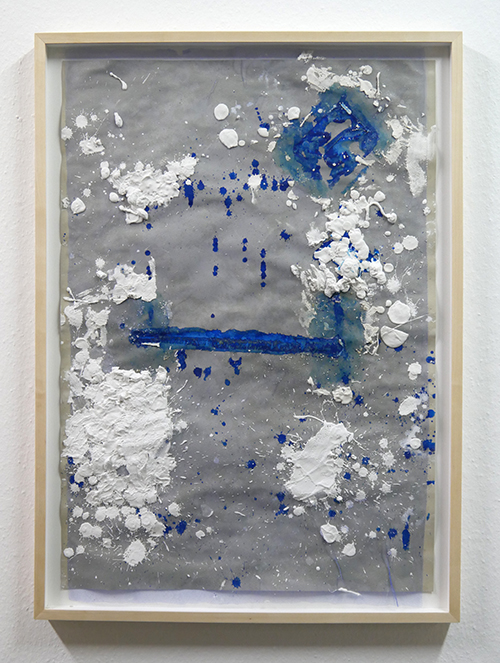
Installation detail: working underlay
2015-2019
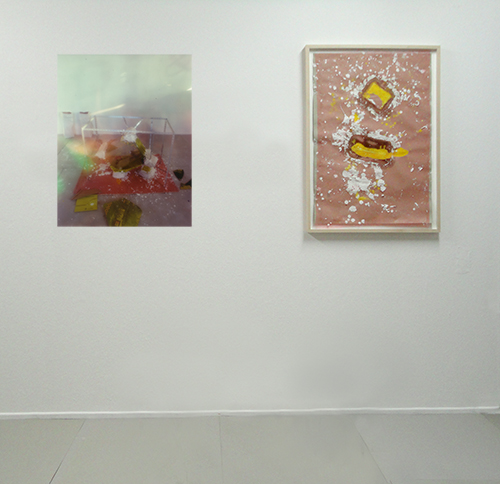
Studio view, Berlin; multi-part work:
– Photograph: C-print
– Plaster, Vaseline, acrylic, textile on paper, framed 109 x 79 cm
Presentation variable. Format and number of photographs variable due to exhibition situation.
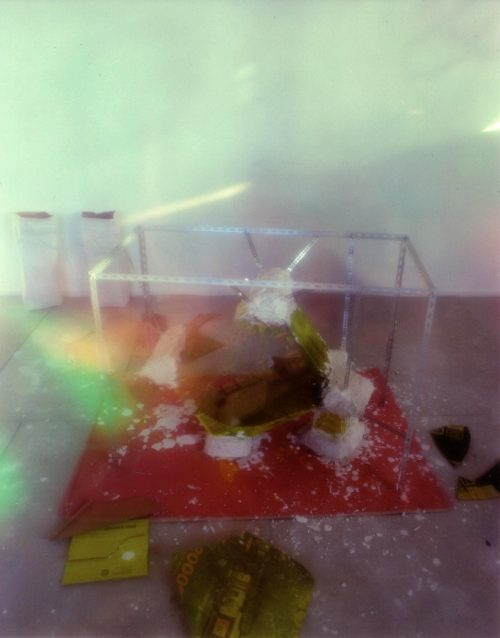
Installation detail: photo, camera: Mamiya RB 67 Pro-S
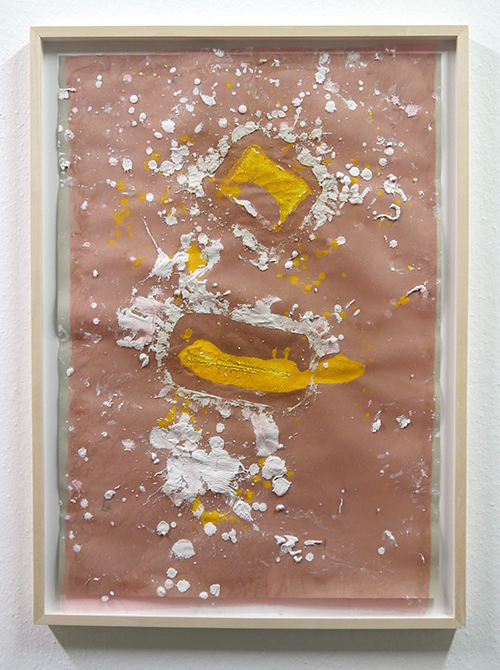
Installation detail: working underlay
2014-2019
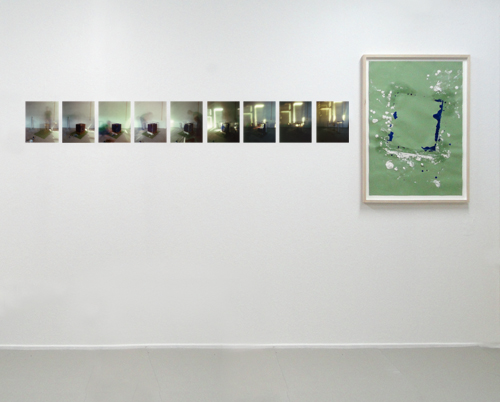
Studio view, Berlin; multi-part work:
– Photographs: C-print
– Plaster, Vaseline, acrylic, textile on paper, framed 109 x 79 cm
Presentation variable. Format and number of photographs variable due to exhibition situation.
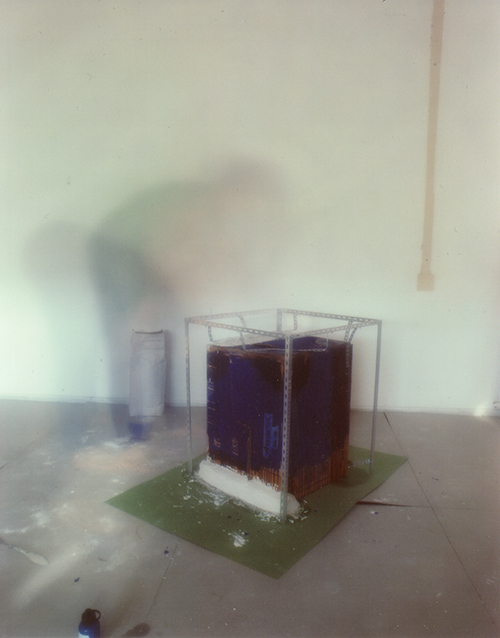
Installation detail: forth photograph, camera: Mamiya RB 67 Pro-S
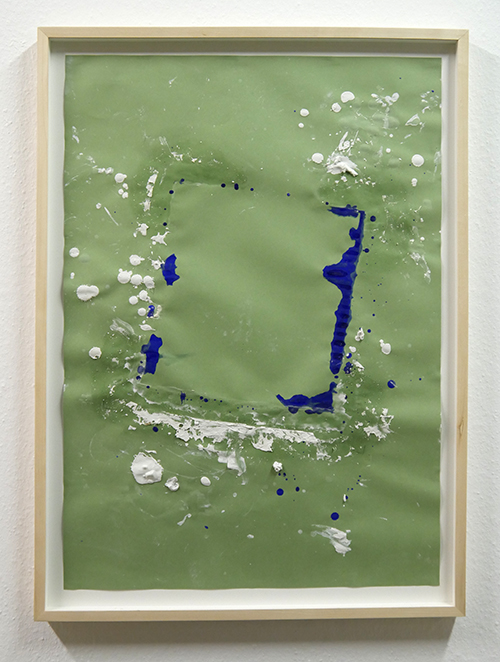
Installation detail: working underlay
Solo exhibition at Lothringer 13, Städtische Kunsthalle Munich, DE.
Opening: 14 December 2006
Exhibition: 15 December 2006 to 4 February 2007
Program with Sabeth Buchmann, Andrea Bührmann, Trend Mensch, Manfred Kleber.
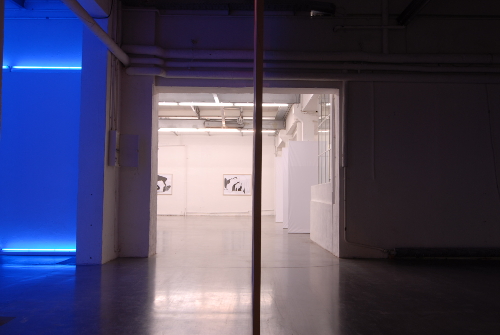
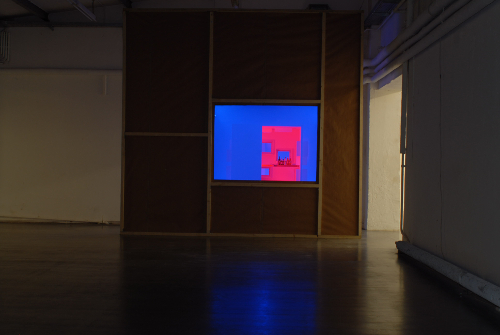
Solo exhibition at Weltraum, Munich, DE.
April 2009
Solo exhibition at Kunstraum Bernsteiner, Vienna, AT.
opening: 29 November 2011 with Andreas Spiegl
exhibition: 30 November 2011 to 24 Januar 2012
2014
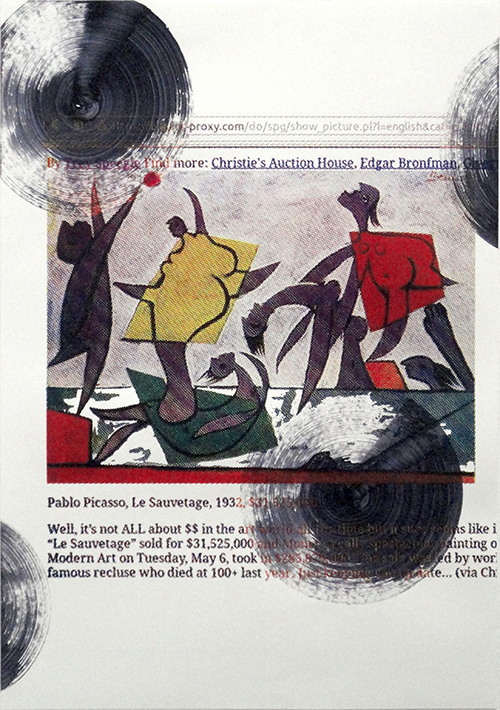
The fourth picture of 4-part work, 100 cm x 70 cm
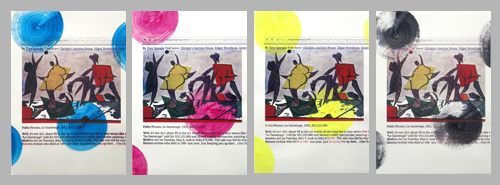
Acrylic and screen print on paper
4-part work; the first of five series each consisting of 4 unique pieces, each 100 cm x 70 cm
The source material is a motif from an art auction website represented by a meta search engine, as a screenshot marked with a colour matte, printed on paper which has been painted with one of the four printing colours respectively.
2014

acrylic, silkscreen print on paper, 70 cm x 100 cm
My works on paper are always to be understood in the context of the performative: concept, reflective attitude, “poetry of action” (Henri Focillon). The mirrored-series is based on the Rorschach method.
„Jamais, entendez-vous, jamais je ne recevrai un ordre de qui que ce soit …“ (Irma Vep)
2014

Acrylic and screen print on paper
4-part work; the first of five series each consisting of 4 unique pieces, each 100 cm x 70 cm
The source material is a motif from an art auction website represented by a meta search engine, as a screenshot marked with a colour matte, printed on paper which has been painted with one of the four printing colours respectively.

The fourth picture of 4-part work, 100 cm x 70 cm
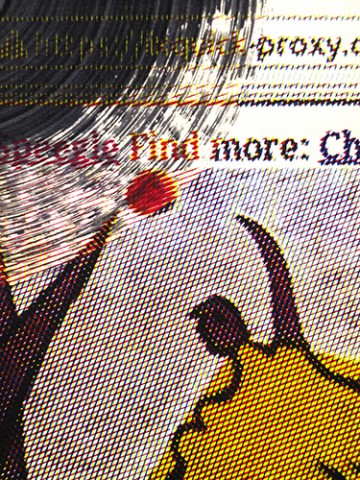
detail
2013
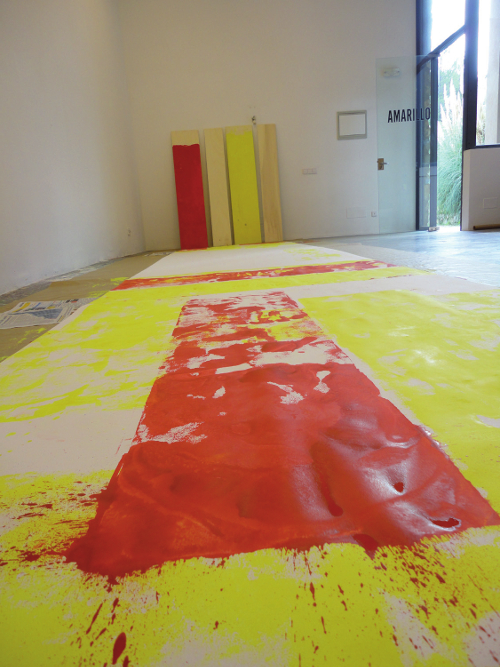
Making-of the intermedia installation MASK_Amarillo (Anti-Mondrian), painting/object/video, at studio Amarillo, CCA Andratx, October 2013.
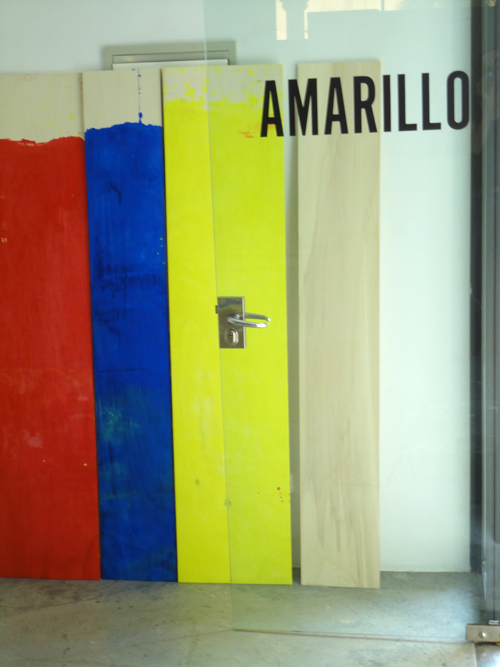
Making-of
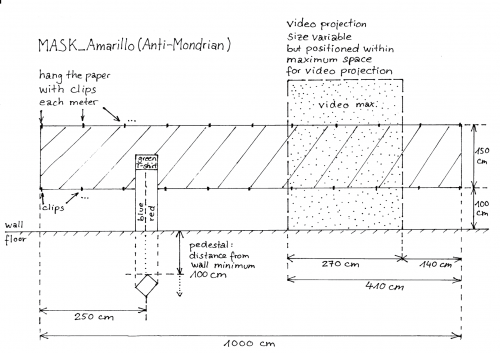
assembly draft
Video, loop, 4 min 17 sec, colour, original sound
Part of the intermedia installation MASK_Amarillo (Anti-Mondrian). Presentation as projection.
2013
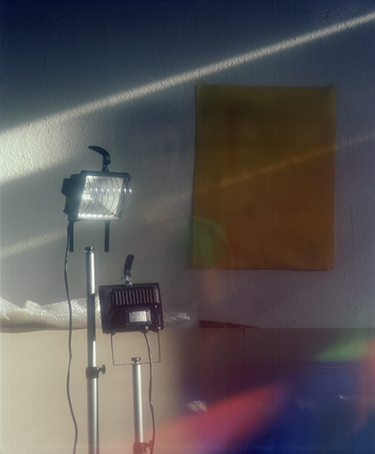
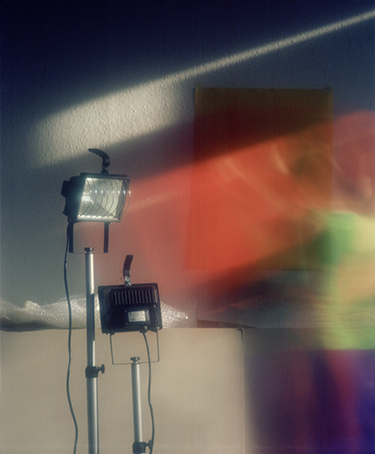
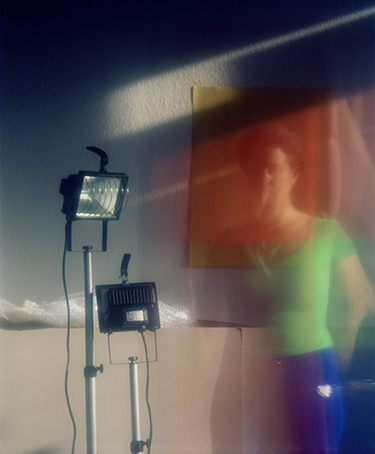
photo performance, three pictures from the 4-part series
My series of photo performances Some Minutes … are to be understood as a continuation of my central subject ‘mask’ in a wider sense. I work with an analogue camera, the Mamiya RB 67 Pro-S. By using self-made filters I can reduce the light entering the camera, so that exposure times from one-and-a-half to fifteen minutes are possible.
During the exposures I operate with different materials, which become visible as traces between planning and chance. The classic topoi of art, such as space/time, presence/absence etc., are currently gaining importance with an “aesthetic of disappearance” in an age of increasing virtualization of social reality.
2013
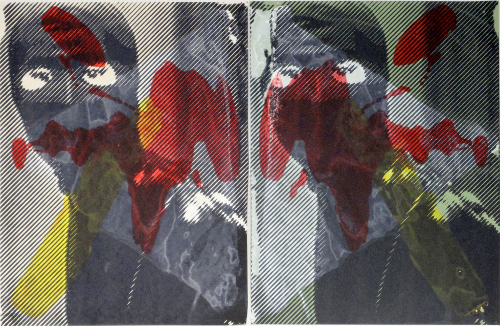
ink, acrylic, silkscreen print on paper, 2-part work, 65 cm x 100 cm
2013
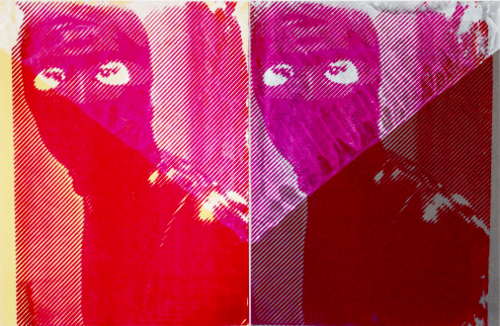
ink, silkscreen print on paper, 2-part work, 65 cm x 100 cm
2013
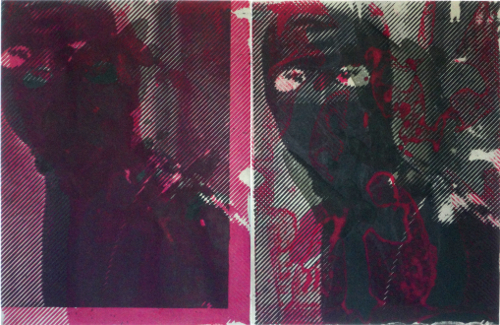
acrylic, silkscreen print on paper, 2-part work, 65 cm x 100 cm
2013
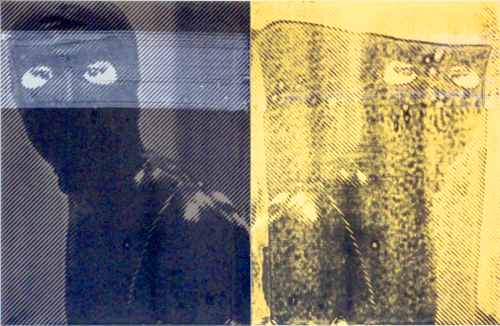
ink, silkscreen print on paper, 2-part work, 65 cm x 100 cm
2013
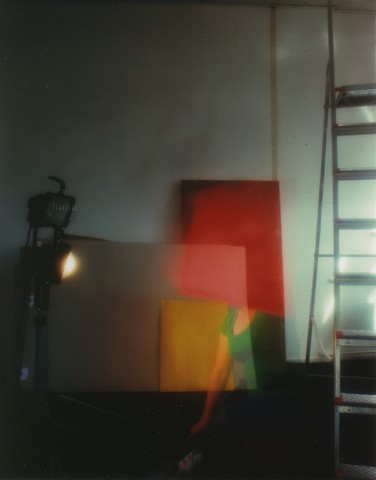
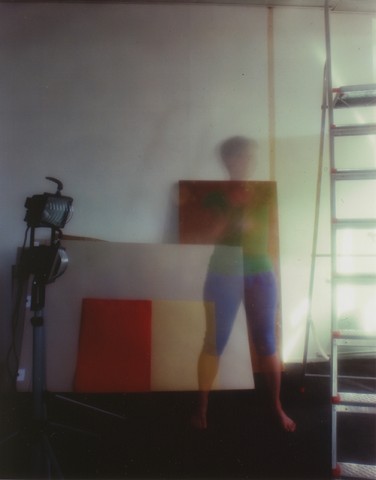
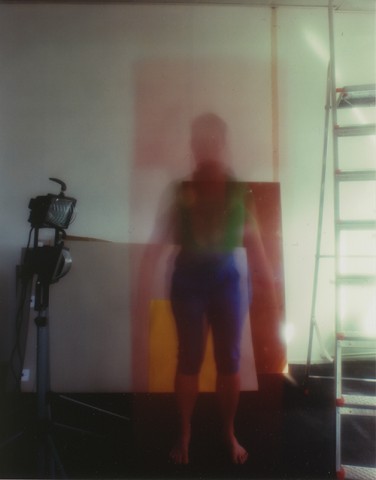
photo performance, three pictures from the 5-part series
My series of photo performances Some Minutes … are to be understood as a continuation of my central subject ‘mask’ in a wider sense. I work with an analogue camera, the Mamiya RB 67 Pro-S. By using self-made filters I can reduce the light entering the camera, so that exposure times from one-and-a-half to fifteen minutes are possible.
During the exposures I operate with different materials, which become visible as traces between planning and chance. The classic topoi of art, such as space/time, presence/absence etc., are currently gaining importance with an “aesthetic of disappearance” in an age of increasing virtualization of social reality.
2013
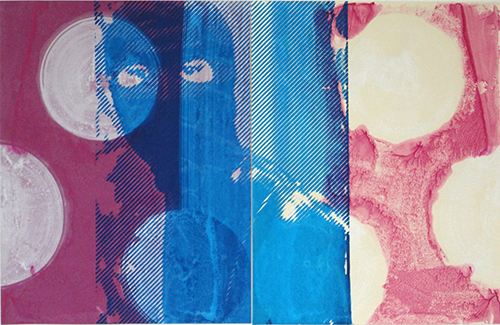
ink, acrylic, silkscreen print on paper, 2-part work, 65 cm x 100 cm
2013
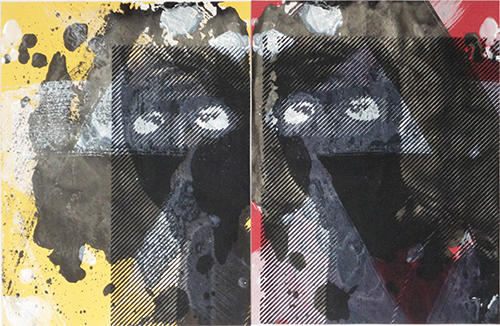
ink, silkscreen print on paper, 2-part work, 65 cm x 100 cm
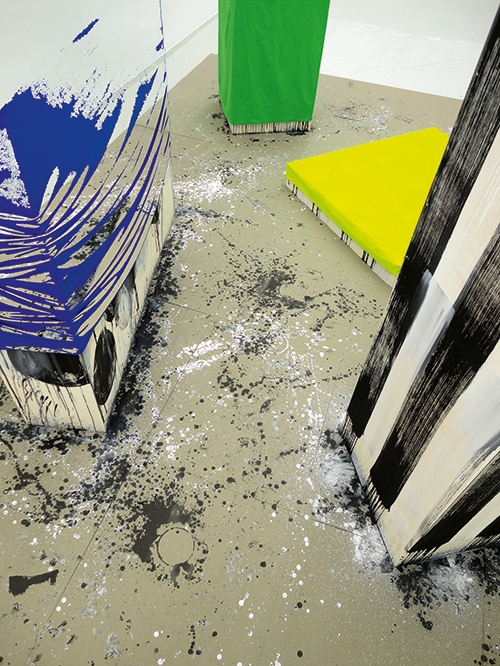
making-of MASK at Kunstraum Bernsteiner, Vienna, AT, August 2011
2012
Video performance, video file, loop, 3 min 25 sec, colour, original sound
Presentation as projection, format variable but width 215 cm minimum
Person #24 combines conceptually video and performance to video performance. In this work I repeatedly perform a choreography of different gestures and poses, which I took from perfume advertisements. It includes the use of several masking techniques: blue stage make-up, dots, squares, technical mask (keying), coloured light etc.
2011
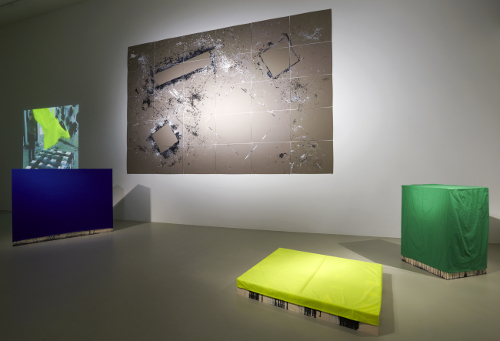
video, 4 min 59 sec, loop, colour, original sound, projection ca. 4 x 3 m
30 age-resistant museum board made from 100% cotton fibre, museum quality, ink, ca. 410 x 615 cm
pedestal: ply wood, ink, with mask made from Foreman, neon yellow, 20 x 157 x 138 cm
pedestal: ply wood, ink, with mask made from Trevira, greenboxgreen, 130 x 76,5 x 76,5 cm
pedestal: ply wood, ink, with mask made from Bluebox-Stretch-Flex, 163 x 190 x 40 cm
pedestal: ply wood, ink, with mask made from textile, retro reflective, silver, 200 x 69 x 69 cm
light
Installation view Kunstraum Bernsteiner, Vienna, AT, 2011 / 2012, Photo: Lisa Rastl
In August 2011 I set up my studio in the Kunstraum Bernsteiner where I created the intermedia installation MASK, which then was exhibited there 2011 / 2012. With black and white ink I painted onto pedestal objects. This process was videotaped with an action cam which was fastened to my arm, and a second camera which was positioned on a tripod. 30 age-resistant mount boards were lined on the floor, to fix the traces of working. In the presentation form the boards are positioned on the wall and the whole installation is staged with spotlights. In addition to this, a video loop is projected in the exhibition space. It is not a documentation of the working process, but a clip that forms one element alongside others. The bluebox-blue, greenbox-green, neon yellow and silver of the masks, which veil the pedestals in the show, are removed in the video by keying or via a colour matte, and so the pedestals, and myself as the acting artist in the close up, partially disappear.
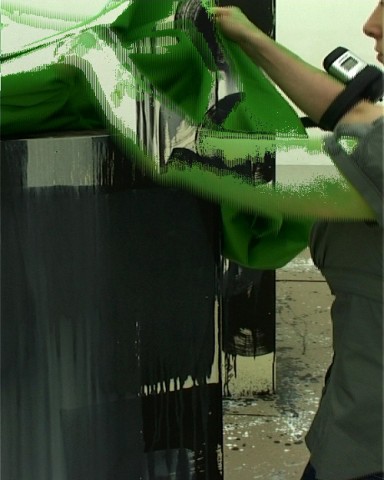
Video still
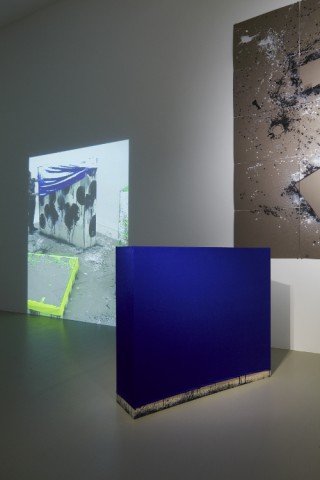
Installation view Kunstraum Bernsteiner, Vienna, 2011 / 2012, Photo: Lisa Rastl
2011
Video performance, video file, loop, duration variable: 8 min 13 sec / 2 min 24 sec, colour, original sound
Presentation as projection, width 140 cm minimum
Person #21 combines conceptually video and performance to video performance. In this work I repeatedly perform a choreography of different gestures and poses, which I took from perfume advertisements. It includes the use of several masking techniques: black and white stage make-up, black and white ink, rectangle, squares, technical mask (keying), coloured light etc.
screening version of Person #21 (2 min 27 sec) at Visual Container
This work is published in /seconds, edition 14.
2009
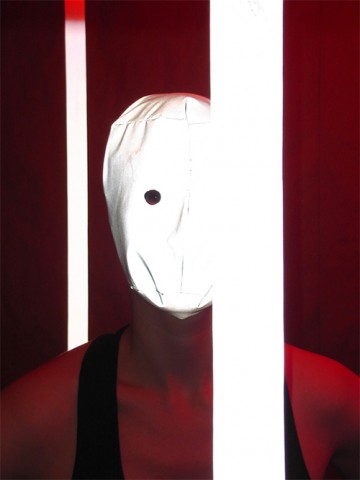
Public collection: Iziko South African National Gallery of Cape Town, ZA
2010
Video performance, video file, loop, 28 min 42 sec, colour, original sound
Presentation as projection, format 105 cm x 140 cm minimum
Person #10 combines conceptually video and performance to video performance. In this work I repeatedly perform a choreography of different gestures and poses, which I took from perfume advertisements. It includes the use of several masking techniques: green stage make-up, paper strips, rectangle, technical mask (keying), coloured light etc.
2010
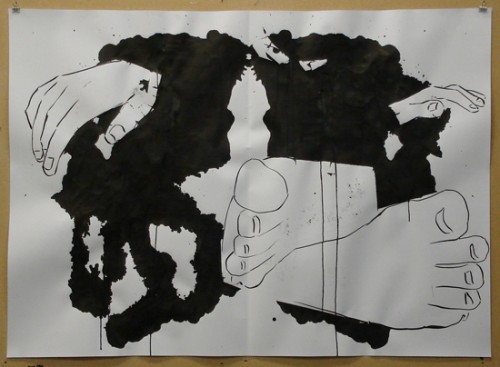
ink on paper, 95 cm x 133 cm
2009
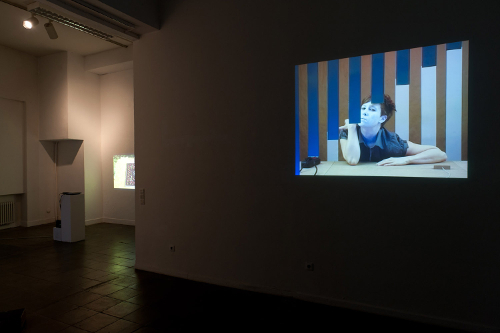
Installation view: Keine Zeit, Künstlerhaus Dortmund, Dortmund, DE, 2016, photo: Jens Sundheim
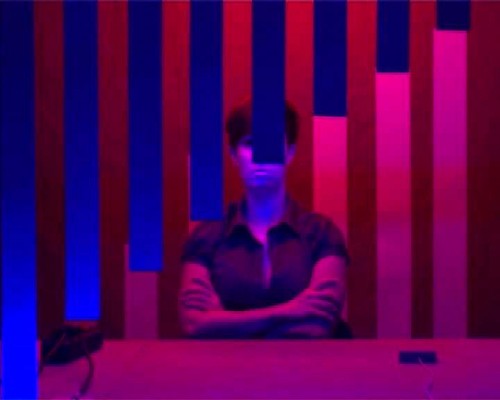
Video performance, video file, loop, 5 min 51 sec, colour, original sound
Presentation as projection, width 140 cm minimum
Person #08 combines conceptually video and performance to video performance. In this work I repeatedly perform a choreography of different gestures and poses, which I took from perfume advertisements. It includes the use of several masking techniques: white stage make-up, reflector strips, paper strips, rectangle, technical mask (keying), coloured light, etc.
2009
Video performance, video file, loop, 6 min 5 sec, colour, original sound
Presentation as projection, width 105 cm minimum
Person #04 combines conceptually video and performance to video performance. In this work I repeatedly perform a choreography of different gestures and poses, which I took from perfume advertisements. It includes the use of several masking techniques: joker greenbox green, rectangle, technical mask (keying), coloured light etc.
2009
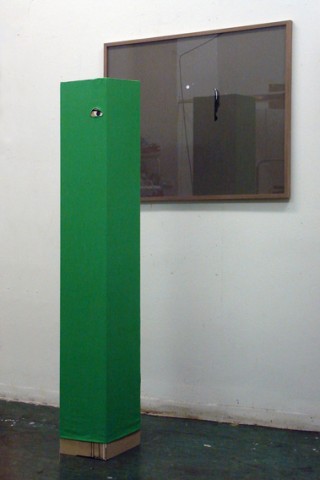
studio view, Berlin; two-part work:
1. Pedestal: raw chipboard, black and white ink, 165.5 cm x 25.5 cm x 25.5 cm; mask: Trevira, greenbox green, 200 g/m², certified poorly inflammable according to DIN 4102 B1
2. Working underlay: age-resistant museum board made from 100% cotton fibre, museum quality, hedge green, 81 cm x 101 cm
The pedestal of Mask_Green #01 corresponds with my body height. The mask is made from greenbox green Trevira, a material that is used for greenbox keying. A working underlay of age-resistant museum board was used to capture the ink that ran down. In the presentation form this board is framed and positioned on the wall.
Making-of:
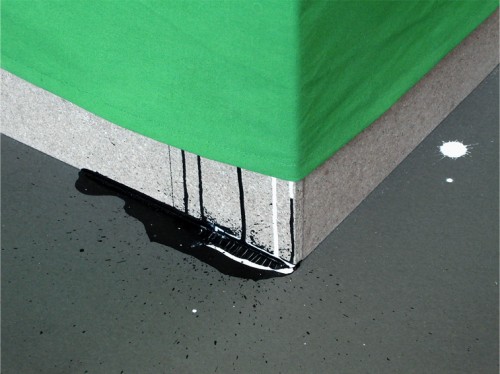
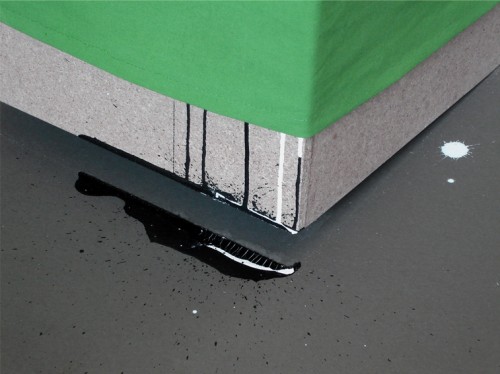
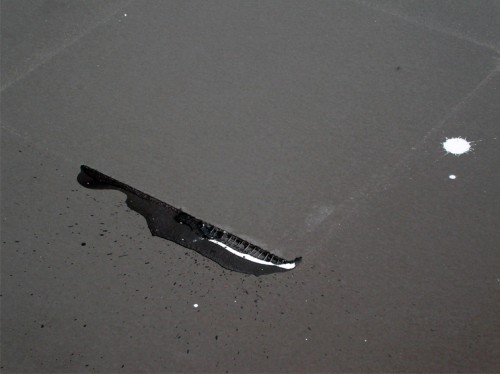
2009
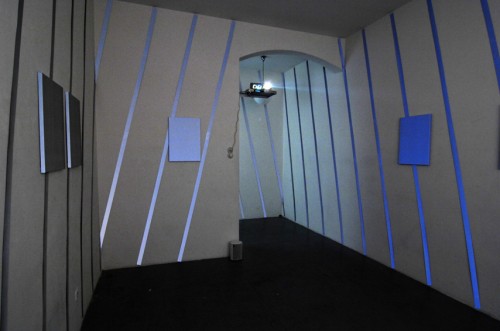
Space installation with reflective textile: 30 strips each c. 327 cm x 5 cm, 5 stretcher frames covered, each c. 40 cm x 56 cm
installation view, solo exhibition Multiple Masks, Weltraum, Munich, April 2009, Photo: Tom Kohues
The projection of the video performance is the only light source in the space. The projected light changes in colour and shines in varying intensity from the reflective material depending on the position of the observer.
2006
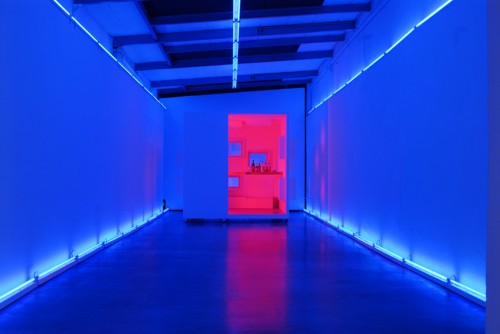
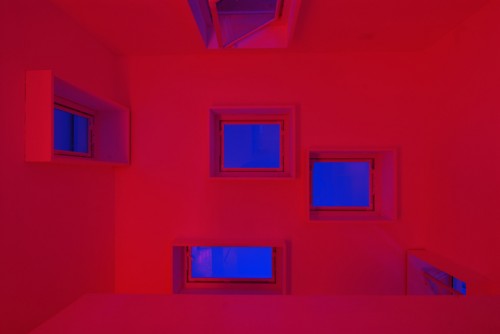
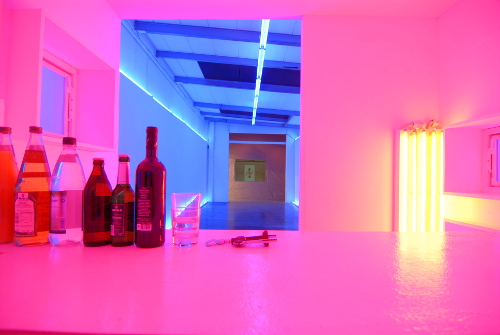
coloured light: deep blue and flame red, installation in mobile bar box at Lothringer 13
installation view, solo exhibition gender gamble, Lothringer 13, Munich, 2006, Photo: Tom Kohues
This work is published at /seconds, issue 5.
2006
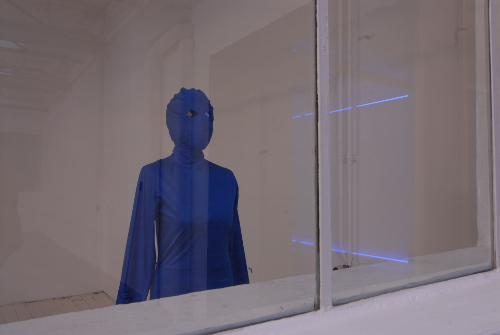
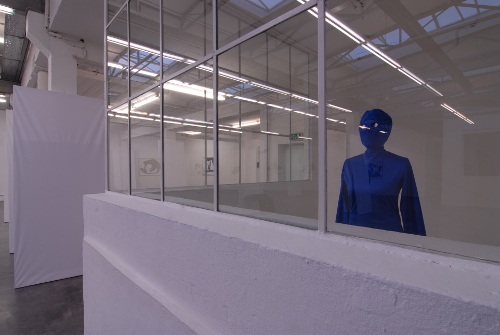
Sculpture, height c. 160 cm: bust with mirror, metal base, chromium-plated; made-to-measure suit made of Bluebox-Stretch-Flex
installation view, solo exhibition gender gamble, Lothringer 13, Munich, 2006, Photo: Tom Kohues
2009
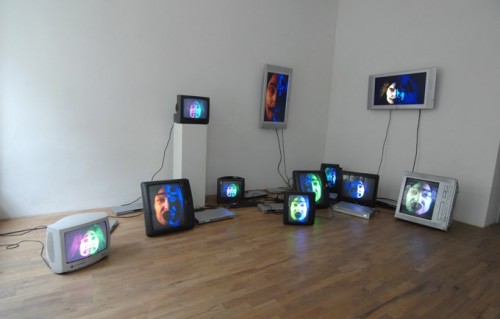
solo exhibition Multiple Masks, Weltraum, Munich, April 2009:
Presentation on eight 4:3 monitors, two 16:9 screens and one 16:9 monitor. Photo: Tom Kohues
Installation with four video works: 16:9 – Maske, 9:16 – Maske, 4:3 – Maske, 3:4 – Maske. The videos are of different lengths and run asynchronously; each monitor has a separate DVD player.
Format variable
2008
Video, video file, loop, format 9:16, 2 min 43 sec, colour, with original sound
The video recordings integrate changing coloured light and several masks: technical mask (keying), make-up mask, wig, facial expression etc. The original sound consists solely of the noise made by the lights being switched on and off.
2007
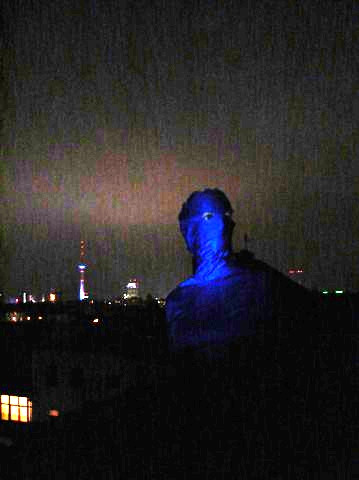
Photo performance; size variable.
Published in Performative Elements, Verbrecher Verlag, Berlin, Dezember 2007, which accompanies the exhibition Performative Elements.
2006
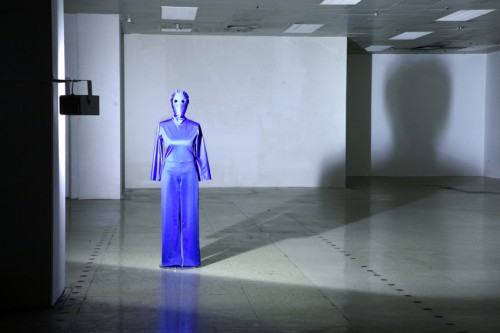
Sculpture, height c. 160 cm: bust with mirror, metal base, chromium-plated; made-to-measure suit made of Bluebox-Stretch-Flex
Installation view, solo exhibition Peformative Elements, art award of Tisa von der Schulenburg-Stiftung, Dorsten, 2007, Photo: Roman März
2006
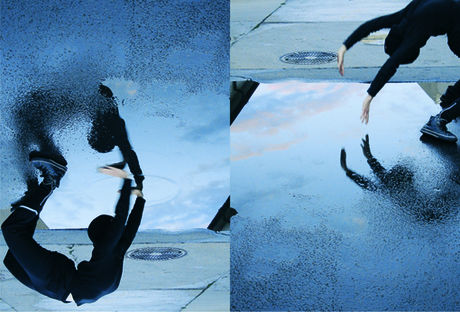
photo performance, published in Stereotype as a Masquerade, Verbrecher Verlag, Berlin, Dezember 2006, which accompanies the exhibition gender gamble.
2006
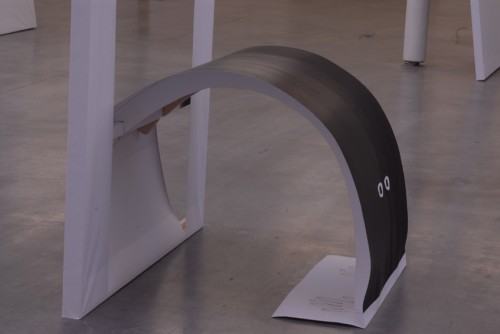
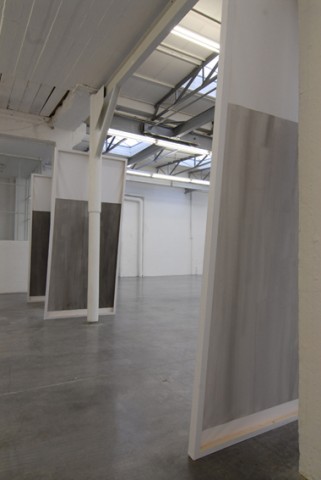
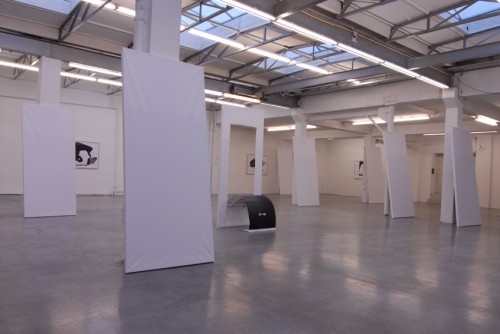
Installation with 9 objects of paper, wood, ink
8 objects, leaning against pillars or the wall, each c. 110 cm x 250 cm x 6 cm
1 object, free-standing, c. 110 cm x 250 cm x 60 cm
Installation views, solo exhibition Gender Gamble, Lothringer 13, Munich, 2006, Photo: Tom Kohues
The ink application on all of the objects results in a transition from white to black. The height of the painted surface relates to my body height with upwardly outstretched arms.
See also: Stereotype as a Masquerade, Verbrecher Verlag, Berlin 2006, p. 40 – 41, p. 43 -50
exhibition view on www.art-magazin.de
Additional photos: Lothringer 13
2005
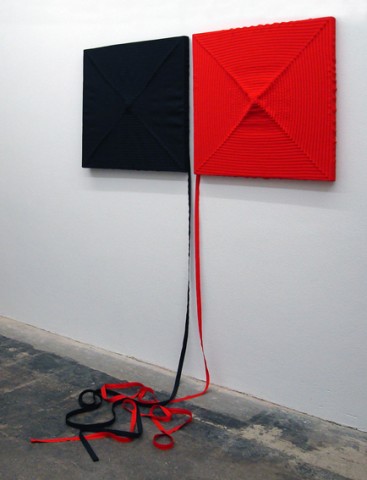
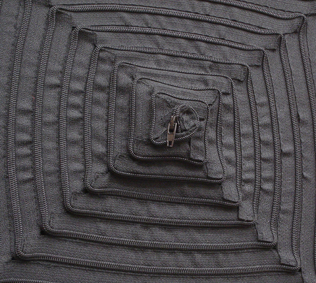
2-part work, 5500 cm red zipper, 5500 cm black zipper, wood
Installation view, solo exhibition oberflächenaktive elemente, Raum 58, Munich, 3 December 2005 to 20 January 2006
The installation consists of two squares, each hand-sewn in spiral form from a single, 50-metre-long red and black zipper respectively. When the squares are positioned on the wall as intended, the approximately 5-metre-long loose ends of the zippers link the squares with the floor.
This work is published at /seconds, issue 2.
2006
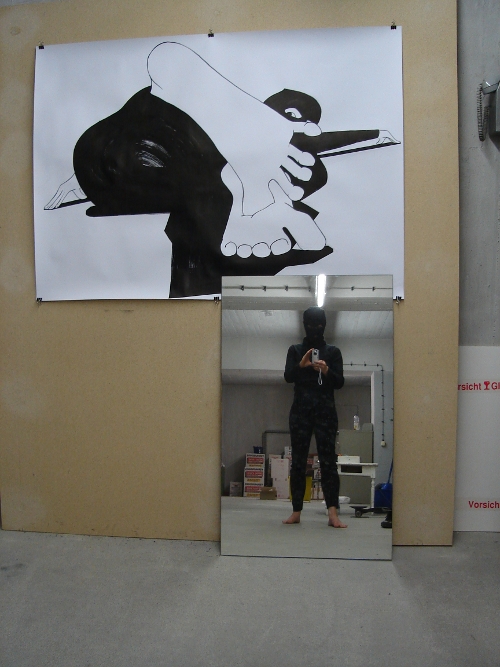
studio view, Berlin; ink on paper, 95 x 133 cm
2005
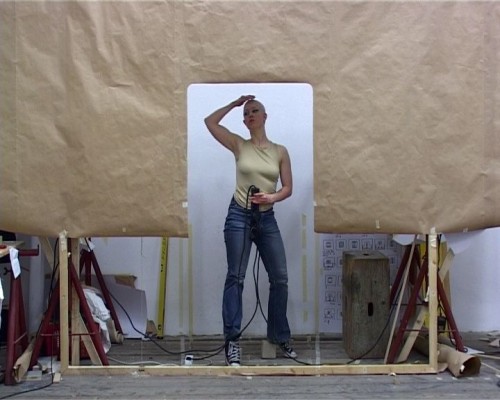
video performance, video file, loop, 18 min 20 sec, colour, original sound
presentation as projection: size minimum 3m x 4m, lower edge meets with the floor
The stage set of the performance fills only half of the video format. In a five-act play I appear with a de-familiarized physiognomy. The choreography I perform is based on poses by a variety of models in fashion magazines. I use two blocks of wood to create all the postures. As soon as I have adopted a pose, I switch on additional lighting on the set. The lower half of the video instantaneously becomes a mirror image of the upper half. The set creates a seemingly perfect façade, the constructions disappear.
2004
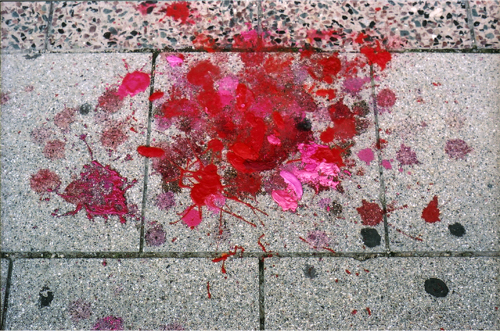
3 September 2004, Berlin, Friedrichshain, Hermann Stöhr Platz, between Käse König and the entrance to Kaufhof. In the framework of SCOPE – Project, art in public space between Ostbahnhof and Karl-Marx Allee, curated by Spunk Seipel.
Waiting only seems to be passive. I coloured my spittle with bitten-off lipsticks. After some 4 1/2 hours the location was marked by the dispositive of a panel painting. Warmed by the sun, the olfactory data gradually unfolded for perception as well.
This work is published at /seconds, issue 2.
2004
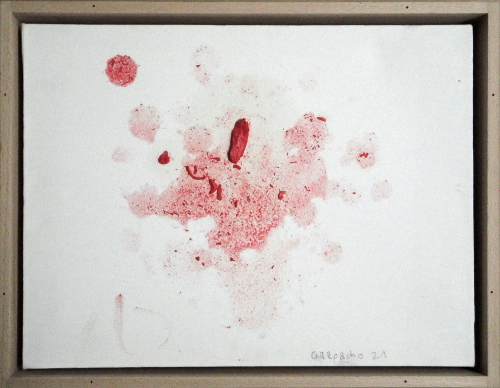
spittle on canvas, 30 cm x 40 cm
I coloured my spittle with a bitten-off lipstick.
The Brazilian Expedition of Thomas Ender – Reconsidered
17 to 30 May 2004
Mark Dion (first naturalist), Dr. Robert Wagner (guide), Franz Christoph Amann (second naturalist), Walmor Correa (botanist), Karin Felbermayr (ambassador), Bartolomeo Gelpi (landscape painter and ethnographer), Christian Mayer (chronicler), Georg Paul Tiller (cartographer)
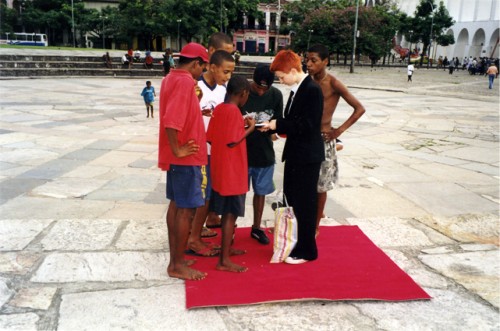
As the ambassador of our expedition, my outfit consisted of a black suit, blouse and sneakers. I always carried a red carpet with me. It was the same length as my body height and as wide as my arm span. Communication with my guests was supported by a text in Portuguese in my guest book:
The Brazilian Expedition of Thomas Ender – Reconsidered
On the occasion of our expedition I invite you to a reception on my red carpet. You are kindly requested to enter your name in my guest book.
Our expedition follows the route taken by Thomas Ender during his journey to Brazil in 1817/1818. Thomas Ender was the landscape painter accompanying the Austrian expedition that escorted Princess Leopoldine.
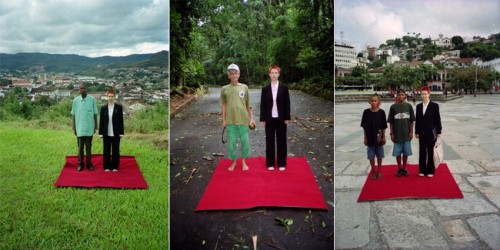
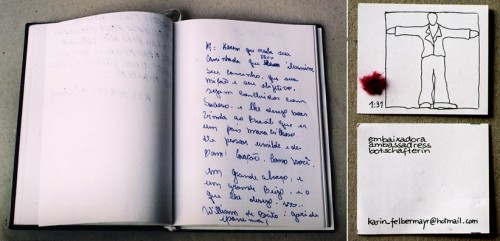
My guests received visiting cards with my email address and a small drawing.
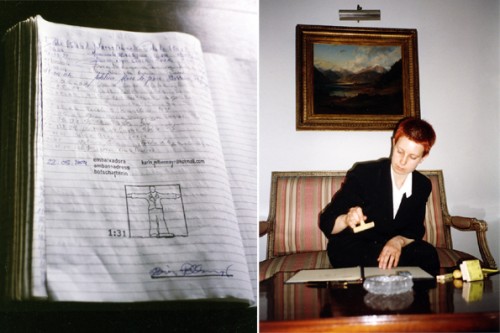
As ambassador I also had special rubber stamps with me, which I used for my guest-book entries in churches, restaurants, hotels and at the Austrian Consulate in Rio.
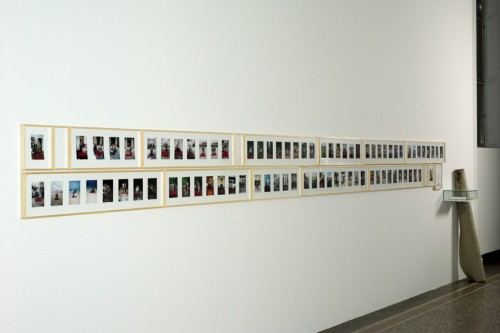
Installation view, embaixadora – ambassadress – botschafterin in group exhibition: The Brazilian Expedition of Thomas Ender – Reconsidered, Exhibition spaces of the Academy of Fine Arts Vienna, Vienna 2005, Photo: Michael Goldgruber
The photographs, which are framed and arranged chronologically according to calendar dates, document my interventions within the framework of The Brazilian Expedition of Thomas Ender – Reconsidered. The photos begin with my first reception with the Brazilian ambassador in Vienna, then continue with those taken during the journey in Brazil and finish back in Vienna at a reception with the Austrian Federal President beneath the original portrait of Leopoldine. Empty picture frames containing simply a passe-partout represent the more-or-less work-free days.
Detailed information about the project The Brazilian Expedition of Thomas Ender – Reconsidered
2006
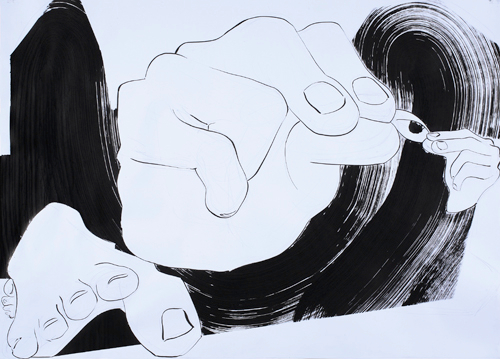
ink on paper, 95 cm x 133 cm, photo: Roman März
2006

ink on paper, 95 cm x 133 cm, photo: Roman März
2006
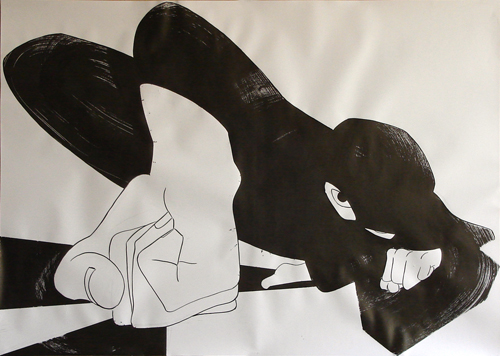
ink on paper, 95 cm x 133 cm
2006
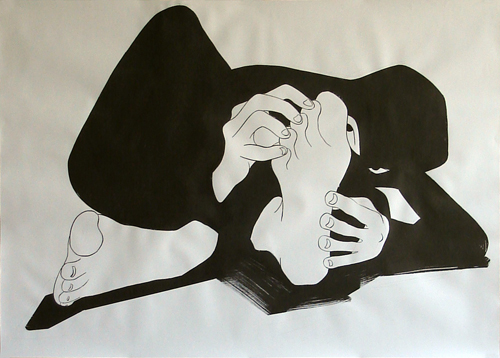
ink on paper, 95 cm x 133 cm